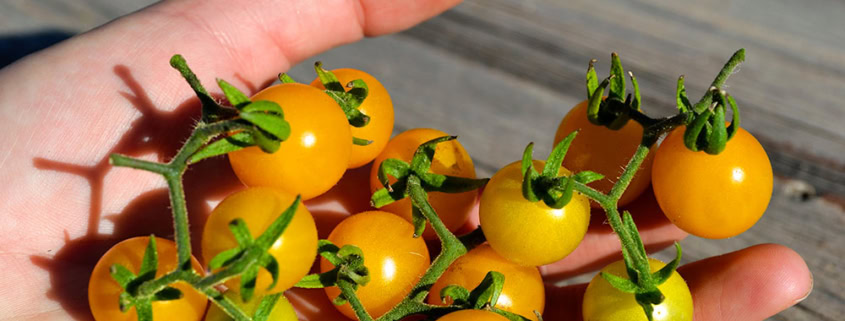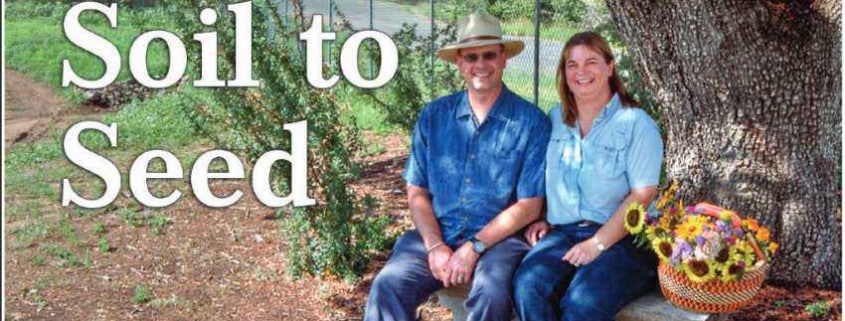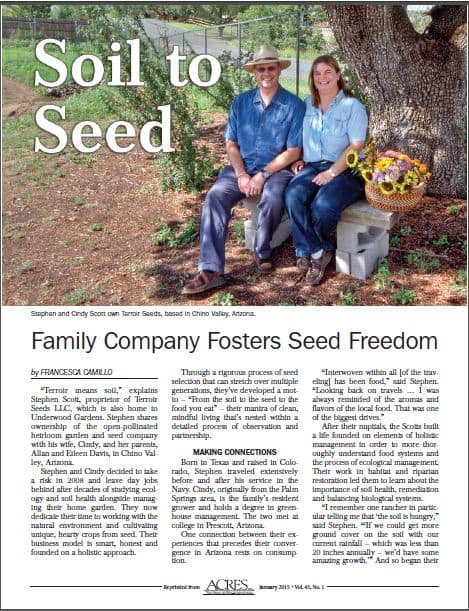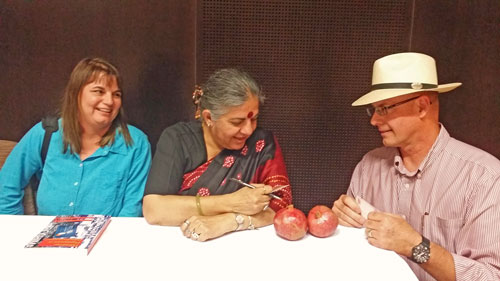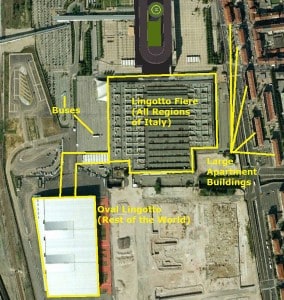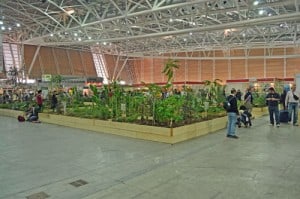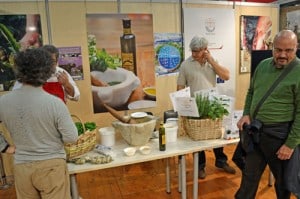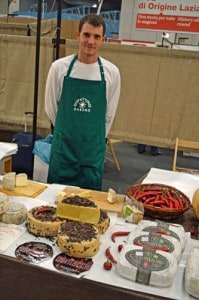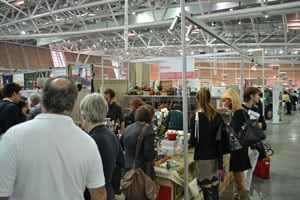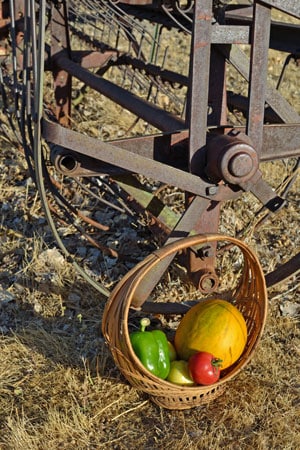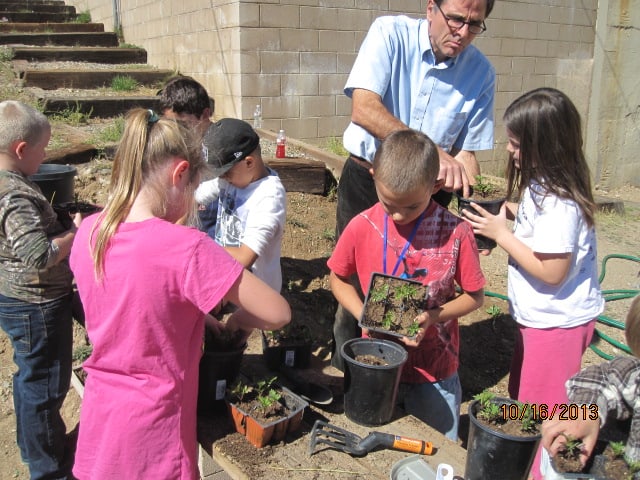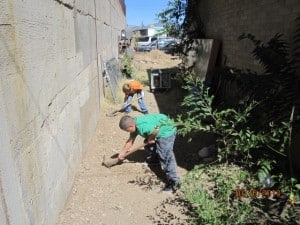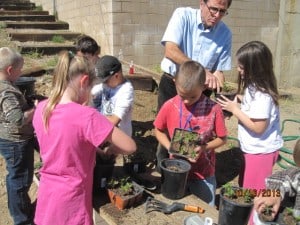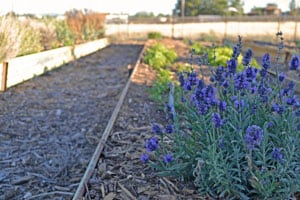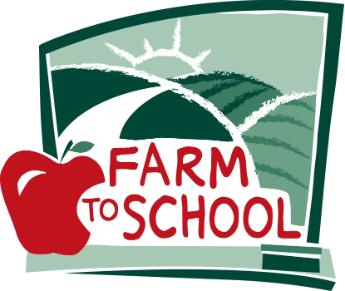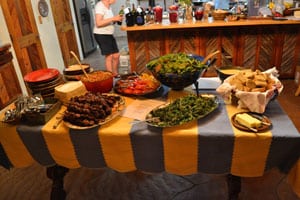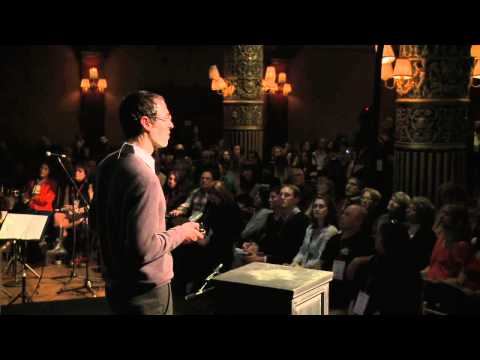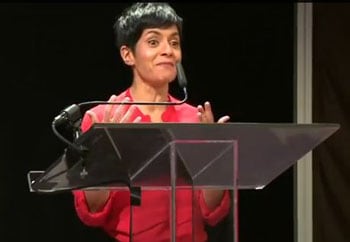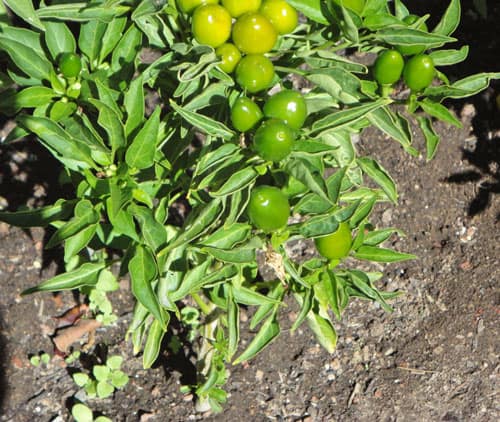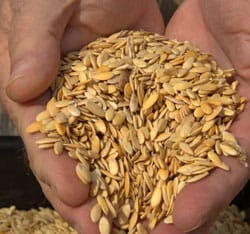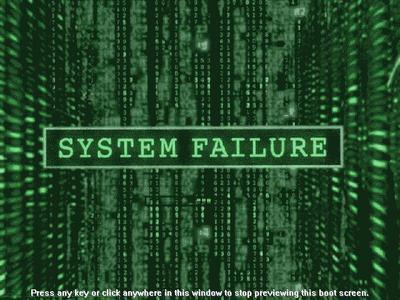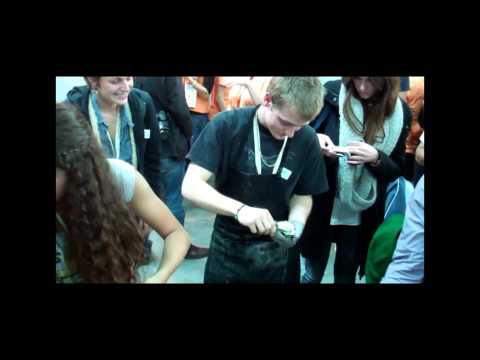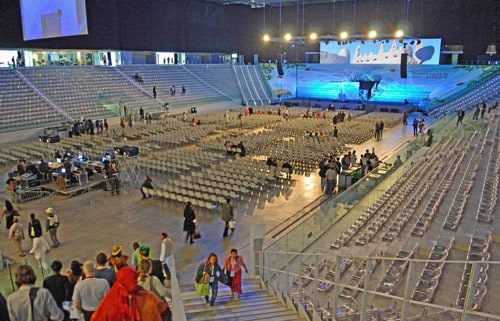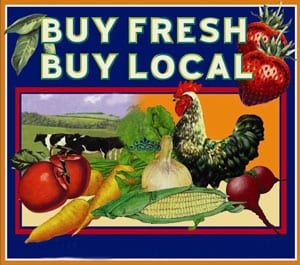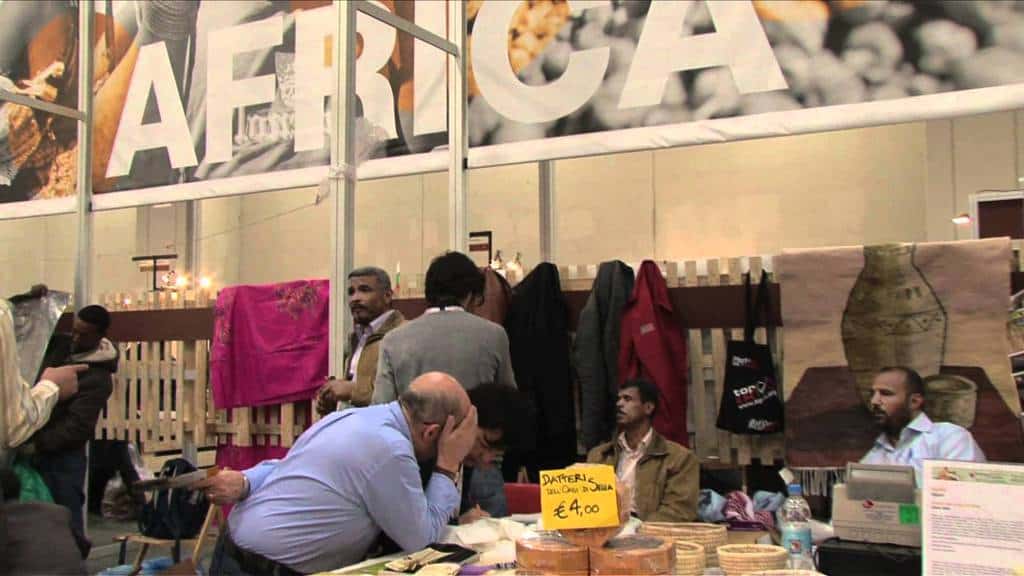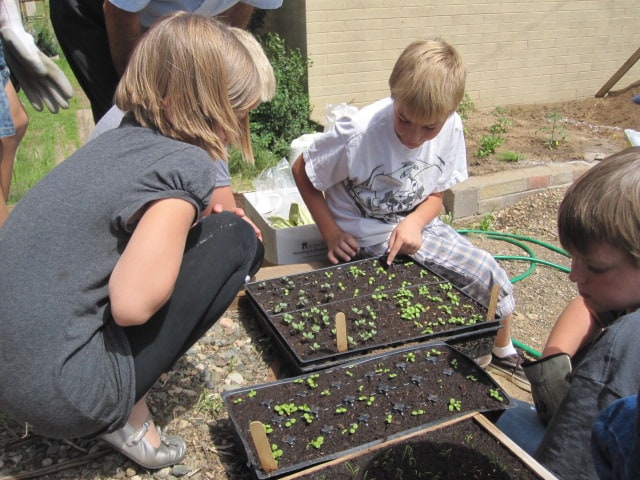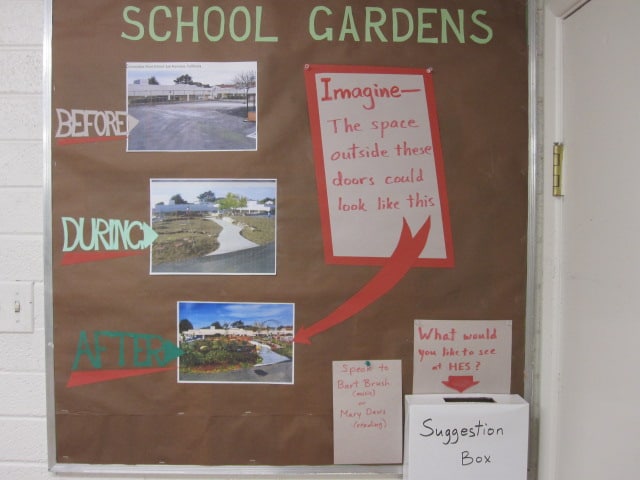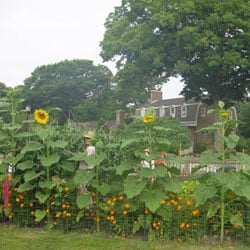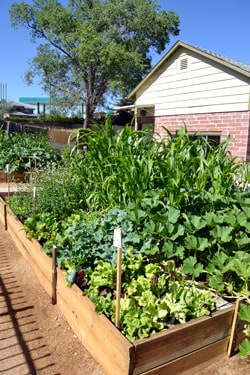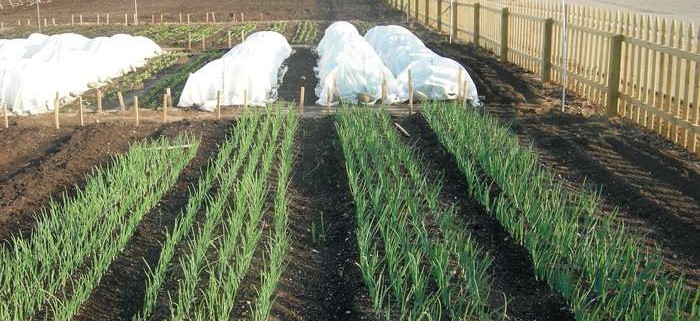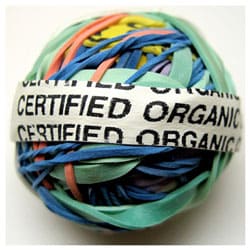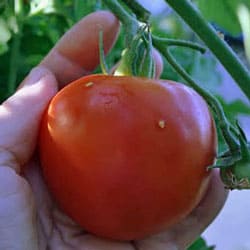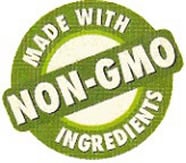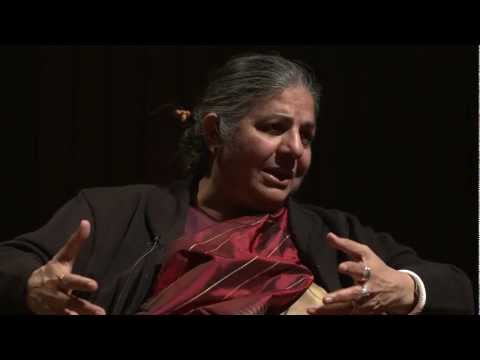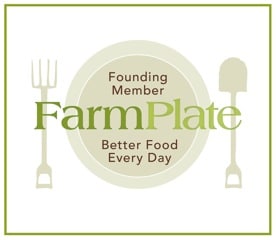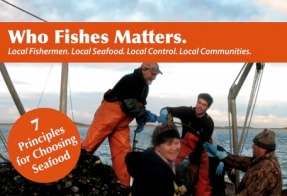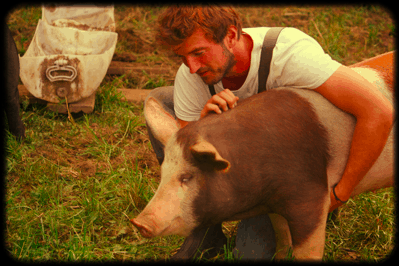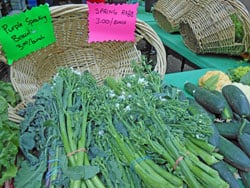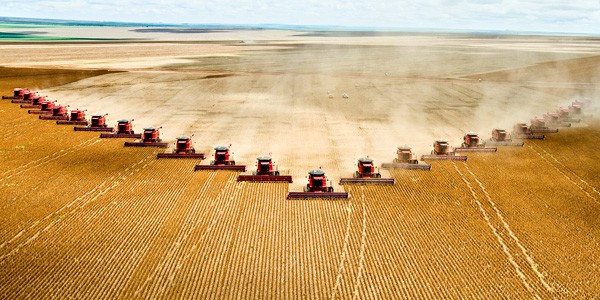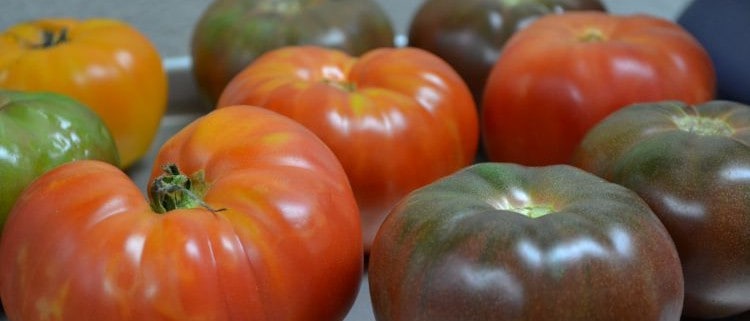Discover the incredible resilience and adaptability of the Wild Galapagos Tomato. Learn about its history and how it’s being used in innovative research.
Tag Archive for: News
Family Company Fosters Seed Freedom
Want to learn more about what makes Terroir Seeds different? We are excited to be featured in the January 2015 issue of Acres USA magazine, the voice of eco-agriculture for over 40 years. This will give you great insight into what makes Terroir Seeds so unique in today’s seed world.
These varieties are featured in the article – Zapotec Tomato, Chile de Agua, Kentucky Wonder Pole Bean, and Rosemary.
Click the photo to read the article!
Food is something that many of us in the US, quite literally, take for granted. We have reached the point where we simply don’t think about it much anymore. This has become both a blessing and a curse.
For most of us, food is always available, never in short supply and the choices can be staggering. Do we want Asian, Italian, Mexican or American tonight? Easy enough. For some, we can drill down much deeper to regional cuisines of the world available for the price of a phone call or a short drive. The selection at the supermarket or grocery store has exploded, with even the most mundane supermarket in small towns offering aisles of international food that have never been seen before in history.
Of course, any discussion of food is by definition a complex one, and the acknowledgment must be made of the less fortunate that live in “food deserts” where the only available food within 30 minutes is at a convenience store; and those that are euphemistically classified as “food insecure” – meaning hungry. Yes, here in America where we are constantly being told that we must “feed the world” with industrial agriculture, we have a dirty little open secret – 1 in 7 or 49 million of our own people don’t have enough to eat, or don’t know where their next meal will come from.
Today we will look at a slightly different picture, that of food as it relates to civilization and how it can affect all of our lives in positive or negative ways. Food can support or topple governments, as vividly demonstrated by the fairly recent events of the “Arab Spring” uprising in the Middle East where food prices and availability brought down established governments in a matter of weeks.
Henry Kissinger’s famous quip from the 1970s rings as chillingly true today as it did then, “If you control the oil you control the country; if you control food, you control the population.”
In light of that, let’s look at some excerpts from Dr. Vandana Shiva’s lecture we attended at Arizona State University’s Global School of Sustainability on October 30, 2014. Her lecture was titled “Future of Food: Dictatorship or Democracy?” For those not familiar with Dr. Shiva, she is a physicist, environmental activist, speaker and author. Her newest book is Making Peace with the Earth.
Food is the web of life, with interactions between different organisms. The soil food web is such an amazing contradiction to that extremely false idea that life is a pyramid with man on top. The organisms in the soil are one step beyond us, we are their food. That should bring us a bit of humility!
How true this is! In our everyday lives, we often forget that we continue to be here thanks to about 6 inches of soil that feeds us multiple times a day, every week, all year long throughout our lifetimes. 2015 is designated as the International Year of Soils by the UN General Assembly, in recognition of the overlooked importance soil plays in all of our lives.
How we produce and consume food is probably the most significant impact both on the planet and society.
Food is more important in our daily lives than we probably realize on a regular basis. Not only does it feed and nourish us, it brings us together socially at mealtimes, holidays and festivities as well as having a major impact in our political system and our national policies, both at home and abroad. The Farm Bill and international trade agreements are just two examples of this importance.
When Dr. Shiva was doing research in the Punjab region of India for her 1992 book “The Violence of the Green Revolution”, she realized that
When you can’t choose what you grow, when you can’t decide the methods of production, when you don’t determine the price of what you produce, when your own rivers’ water can’t be released through your decision, then you are living under slavery.
When she said this, it immediately brought to mind the situations of some of our farmers, especially the contracted chicken and pig producers, as well as commodity crop growers who are locked into multi-year contracts that specify everything – the seed, chicks or piglets to be used, what feed or fertilizers, pesticides or herbicides will be applied, the length of time until harvest and what price will be paid by the buyer after harvest. There are often punitive clauses that penalize the grower or farmer if conditions or quotas aren’t met. Some large operations, corporations themselves, do well in these contracts, but family farmers do not often find them beneficial in the long run.
A dictatorship is control of an absolute kind. Look at what is happening to our food system – seed, the first link in the food system is being controlled like we’ve never seen before. It was not controlled before, it was shared. We had public universities breeding seed, and they would share the seed. Farmers would share seed with each other.
The issue of food dictatorship begins with the seed, goes into food, goes into our knowledge, goes into how our decisions are made, because governments become involved with the laws they make.
This is a very important point that is not addressed much in today’s food system discussions; the very beginning of the entire food chain comes down to a seed. We have seen the incredible consolidation of almost an entire industry in a little more than a decade. From dozens of companies, we now have 6 that control 80% of the commercial seed supply worldwide.
In decades past, land grant universities bred new open pollinated varieties and shared them with growers in their state. Those growers further selected for the best traits and passed them along, partly sharing and selling. The USDA had a large breeding and research section that would send seed home with Senators and Congressmen when they went back home on the train. Farmers and growers could subscribe to the USDA’s publication, read about new varieties they were interested in and write for samples of seed to try. Bear in mind, these weren’t “Free” seeds; they were paid for by taxes and funded through the agricultural programs of the USDA. The growers and farmers didn’t pay out of pocket for them, but paid via their taxes.
Now, there are very few public universities doing seed research and breeding that are releasing them to the public. The notable exception was in April of 2014 when the University of Wisconsin, Madison ‘Open Source Seed Initiative’ project released 29 new varieties of seed for 14 different crops. Because this type of program was so unknown, many articles and Facebook posts erroneously trumpeted the “Free Seed Initiative”, creating confusion as to what this breeding program was trying to do. The aim of this project is to get new open pollinated seed varieties into growers hands so that they can become available for the public.
This is what seed democracy and by extension, food democracy, looks like. This is what is happening with every small, independent heirloom seed company that works to bring overlooked heirloom seed varieties to market. It is also what is happening with the explosion of Farmer’s Markets across the US, as well as the sustained double-digit growth in the resurgence of the home based backyard garden. Local food hubs and food production systems are being re-thought, re-engineered and re-designed like never before. Farmers and growers who used to see themselves as ‘competitors’ are now beginning to view each other as ‘collaborators’ or ‘co-creators’ in new ventures, with an improved local food system as the result.
Seed sovereignty is the very basis of food sovereignty, of food democracy. Every UN study shows that small scale agroecology produces more food than industrial chemical agriculture. The United Nations Environmental Program 2012 study “Avoiding Future Famines” defends the ecological foundations of traditional, sustainable agriculture.
Something like 70% of the food we eat worldwide is still grown today by small farmers. This has been true for centuries in places like Russia with its ‘Dacha gardening’ system growing close to 50% of the fresh food by the people, for the people. Food democracy can exist, even under the strictest non-democratic governments!
The biotech companies produce seed that is very costly; it is only the governmental subsidies that produce food that is cheap. There is $400 billion in agricultural subsidies – a billion dollars a day!
If that tax money was diverted from subsidizing toxic food that’s destroying the planet and destroying our health and shifted to growing food that protects our health, protects the planet and generates employment in the process, then we could begin to reverse the agricultural damage to the world.
75% of planetary damage to soil, water and biodiversity and 40% of the greenhouse gases comes from global industrial agriculture. This is the single biggest impact on the planet, and yet ecological farming and local food systems can be the place, maybe, to do the opposite. We can rejuvenate biodiversity, we can save seed, we build up organic fertility of the soil, and we conserve water.
This is big-picture thinking, but on many scales it makes sense in many ways. Voluntary, participatory and evolutionary seed breeding projects that are not corporately involved can be very strong food security and food democracy measures today. In times of changing climactic conditions, the plants must be allowed and encouraged to adapt to the current agricultural conditions. Farmers have done this for centuries, evolving salt tolerant or arid varieties that continue to produce food during changing times.
A perfect example of this was after the 2004 Tsunami in Thailand and Indonesia. Dr. Shiva’s foundation, Navdanya, a participatory agricultural research program – gifted 2 truckloads of salt tolerant seeds to the farmers, who had been told that no agriculture was possible for 5 years by their government agricultural resources. The seeds didn’t just survive; they did extremely well and have been saved and shared all across the region. Seeds are hope, the hope for our future. They are the real diversity, the real insurance for the future, whether it is climate change, to create democracy or deal with pest and diseases.
What is your role in creating a food democracy instead of a food dictatorship? Do what you can – grow a garden or expand it, help others garden, grow a row for the hungry and donate it to your local food pantry, buy at the Farmer’s Market, buy a CSA share from a local grower, and choose the closest grown produce at the supermarket. Each of us individually may not be able to influence farm policy, but we can make a change in our daily food, and that is where real, lasting change starts.
We were asked to write about our experiences as Slow Food USA delegates to the 2012 Terra Madre conference in Turin, Italy as information and details for the 2014 delegates. Here’s our story!
Terra Madre for the First Time
The Terra Madre gathering was something Cindy and I had heard of several times during our decade long Slow Food membership, most often at Slow Food events in Flagstaff or Phoenix, AZ. Our formal introduction was a presentation by a college student who attended the 2010 event with her family who are farmers from Oregon. The photos and descriptions were sensual and alluring, drawing us into a different world where food is revered and the producers and chefs are celebrated. The young woman was at a loss for words a number of times during the slide presentation and we attributed it to nervousness or lack of public speaking experience. Later on, we would come to realize that there really are no words to describe the entire experience; only bits and pieces, thoughts, ideas, flavors, aromas and sights. Even two years later it is difficult to capture many of the sights, sounds, flavors and aromas with words.
Once our applications were in, we fervently hoped that we would be chosen as the experiences would be a keystone in our lives, both personally and professionally. You see, we are not only serious foodies, but have an heirloom garden seed business named Terroir Seeds that focuses on why the quality of the soil influences the resulting flavors from the garden so much. We felt that attending Terra Madre, meeting the growers, producers and chefs along with the sights, textures, tastes and scents would better our understanding of food and why its origins are important.
When the email arrived announcing our selection as Delegates, we began reviewing the events, conference topics and taste workshops along with the International Congress schedule. We had been selected as Congress delegates as well as Terra Madre ones, so had an extra schedule of meetings and presentations from 130 countries around the world. The sheer number of things to do, see and taste was overwhelming! Fortunately, we were able to attend a “Pre-Terra Madre” event hosted by Slow Food Phoenix with other new delegates along with experienced attendees that gave us some very valuable and useful information that made our trip more enjoyable.
Probably the single most important tip was that we would be on “Italian time” and not to worry. Things might not seem to be progressing like they would in America, but it would all turn out well in the end. They were right, we did get where we were supposed to be even though there were thousands of people from all around the world speaking many different languages. The logistics must have been a nightmare, but everyone was polite and friendly.
The other great tip was to expect the first day to be very long, exciting and exhausting. We landed in Milan mid-morning and didn’t get to our hotel until after midnight, after a trans-Atlantic flight starting in Phoenix, AZ at 7AM the previous morning. Our schedule didn’t allow us to arrive a day earlier, but if you can it will help to have a full night’s sleep before starting the marathon that is Terra Madre!
Another tip that is not immediately obvious, but will prove to be invaluable as time goes on is to take lots and lots of high-quality photos. Documenting the experiences will revive memories that fade shockingly fast. Looking at a single photo, I can still vividly remember the Provolone cheese being opened up early on the second morning. The indescribably delicious and powerful aroma, along with the complex and lasting flavors were an eye-opening experience, showing us that we hadn’t tasted anything close to this in the US.
When we landed at the airport in Milan, we were with a large group from the USA, along with people from several European, African and Asian countries. The bus ride to Turin was spent getting to know others, finding out what they did for work as well as what things they were doing in their area that related to Slow Food. It was a real eye opener to see how many creative, passionate and dedicated people there were in every conceivable situation all over the world working to make food more accessible, better and healthier for everyone. We felt like we were re-discovering a tribe we belonged to but hadn’t known we had lost. It was a homecoming of sorts, a place the heart knew well but the eye hadn’t yet seen.
After checking in at the Oval Olympic Arena, also known as the Oval Lingotto, we stashed our luggage and wandered over to Eataly for cappuccino and snacks. It was a great introduction to the event, as it seemed to be a Slow Food superstore! Every area in Italy and from other regions of the world was represented, with signs and cards explaining where the food was from and why they were special. We had been advised to eat often the first day and get a cappuccino whenever we started to feel a bit tired. Italian cappuccinos are much smaller than we are used to, so they were the perfect pick-me-up during the entire event.
Once we had fueled up, we wandered back through the Lingotto Fiere as the booths were finishing set-up. The event is held in part of the repurposed Fiat factory, and is huge. The stroll through the vast building really wet our appetite for the next few days! Several of us made notes on specific booths and stages we wanted to come back to visit. Even after spending most of 3 days in there, we missed seeing a lot. The sheer size is vast, much bigger than the entire Las Vegas convention center or other convention centers we’ve visited, and they are filled with food!
The opening ceremonies were held at the Palasport Olimpico – also known as the Palaisozaki after the Japanese architect Arata Isozaki – where we were bussed and re-deposited our luggage at a baggage claim area. As the arena started to fill up, we talked to more people and snacked on fresh made sandwiches and more cappuccino. The opening ceremony was impressive with a warm welcome from the officials from Turin, along with an incredible flag procession from each country attending. Afterwards, we walked to our group of buses for the ride to the hotel.
The next 4 days were a whirlwind of food tasting, cooking demonstrations, learning the history of a regionally famous food and bumping into all sorts of people, like Alice Waters, Vandana Shiva and the ever-delightful Carlo Petrini. We were continually impressed with how friendly, helpful and engaging the artisans were, eager to share their knowledge and experience of their particular food, along with delicious samples. It was great to spend a little time at a booth, talking with the family that produced the food and learning more about their lives and how much work or experience went into each taste we had.
They were equally interested about our lives in America, with most being fascinated when we said we were from Arizona. Many Italians want to see the Grand Canyon, and a surprising number had been there or in other parts of the southwest. They always wanted to compare food notes, what we ate, what we raised or grew and what we considered to be our “traditional” foods. That was difficult, as the USA is truly the melting pot! They were fascinated at the variety of foods we ate on a regular basis and were impressed that we didn’t live off of McDonalds or other fast foods. Yes, American commercialism at its best!
On the other hand, we received a valuable lesson in viewpoint when we were at the La Vazza booth sampling regional coffees paired with a traditional treat. The young woman guiding us through the selections was a student at UniSG – the University of Gastronomic Sciences that is part of Slow Food in Italy. When we remarked on how wonderful it is to have an event like Terra Madre celebrating traditional foodways, she commented that what we were seeing was indeed special, but everyday Italians were much more like Americans in the respect of wanting convenience and “progress” in their food choices, so traditional ways were declining. We were surprised, mainly because of the image of Italy as a bastion of traditional, honored food systems and regions. During our conversation, we learned that there was a very strong movement in Italy to continue the local and regional foods that had become more sustained and successful. Part of this was due to the influence of Slow Food in Italy!
In talking to the growers or vendors about their foods, taste and flavor were always one of the first things to be mentioned or demonstrated. Those were the primary concern, with everything else being secondary. What a refreshing change for us, where we are used to flavor being heavily advertised but rarely well represented! When we would talk about wanting to bring seeds back and introduce those varieties to the American public, the very first comment – always – was, “It won’t taste the same!” They were right, of course, but we were looking to introduce flavors and different varieties of traditional vegetables that are unknown here. After some discussion, several growers understood what we were trying to do, but always came back to the flavor being different. They were happy to see that we were trying to spread the word about the uniqueness of their foods, however.
With all of the centuries of traditional food production, some with defined methods dating back 300 to 400 years in an unbroken line, there were definitely creative twists and experimentation represented. Several craft breweries were showcasing their approach to small batch, handmade beer with unusual herbs and spices, all of which were completely different than what craft brewing is in America, but completely delicious. One family of cheese makers from southern Italy stand out in our memory, as the son was telling us that he had been in the international banking business but had returned to making cheese after the economic downturn. He showed us several of the traditional aged cheeses his family had been making for over 100 years. Then, with a bit of awkwardness, he introduced us to his own creative twists – aging cheese in the local winery’s grape must, or crushed grapes, for a completely different approach and beautiful flavor for his goat cheeses. He said that the local area thought him crazy at first, but were starting to come around after several years of tasting his new cheeses.
If one story can sum up our experiences at Terra Madre, it would be this: during the International Congress presentations, just before lunch, a young Palestinian woman spoke about the hardships and challenges her community faced in finding land and enough water to grow fresh food for their villages CSA or community supported agriculture program. As she started speaking, the entire room grew quiet and charged with anticipation, waiting to hear what she had to say. Their village was split by the dividing walls, and her talk was charged with emotion and passion. Despite the incredible challenges, she talked about the successes they had gained, growing more and more food to feed themselves and gain a measure of self-respect and resiliency. We broke for lunch after her presentation.
Soon after the break a young Israeli man got up to speak, and the room once again became silent and charged with anticipation. After he introduced himself, he stated that not all Israelis supported the current program, nor were all antagonistic against the Palestinian situation. He then described his village’s challenges in obtaining enough land and clean water to grow fresh, healthy food for his community, which was also close to the dividing wall. After a couple of years, they were able to grow more and more food, gaining some independence from the food trucks that so many were living off of.
Both young people exemplified what we saw time and time again at Terra Madre – individuals in all kinds of situations and conditions all around the world working diligently day to day to make a positive difference where they lived, no matter the beginning challenges. It really gave us hope that what Slow Food stands for – good, clean and fair food – is a powerful, positive change in itself.
While we may not agree on many things – religion, politics, race, nationality and economics – we can agree on the foundational importance of food and our need to eat and eat well. Maybe, just maybe, food is that place where we can meet, eat and begin to find more common ground to agree on.
We are very happy to share an editorial that Stephen wrote for the Spring 2014 issue of Small Farmer’s Journal. SFJ, as it’s known, has had a large influence on us for a very long time. It is one of those jewels of a publication, wrapped up in its plain brown paper cover, but holding viewpoints and articles that expand one’s mind, or perfectly sum up thoughts on a subject, or inspire or educate on something that you hadn’t really thought about before.
We’ve contributed articles before, but were very honored when Lynn Miller asked for an editorial. He didn’t specify the subject, so we went with what was most in front of us at the time, drawn from a number of conversations with customers from all across the country, along with material from a couple of recent presentations. We hope you enjoy it!
Our perspective is somewhat unique, based as it is on contact with home gardeners and small scale growers across the US and Canada, along with a number of other countries. Our phone and email conversations are filled with happenings from all over, from cities with community gardens, church and school gardens, to chefs working with growers to bring fresh, sustainable and locally sourced food to the forefront of their cooking, to prison systems that are going back to raising some of their own food for the lower costs, higher quality food and better rehabilitation that a working garden provides.
Canning classes are oversubscribed, seed starting and planting lectures are full and ordinary people are beginning to ask about how to grow food without using so many chemicals, pesticides and herbicides because of their concern about what they are eating. It is no longer unusual to get an email asking if we are connected in any way to the bio-tech companies, if we use herbicides in growing our seeds or if our seeds come from China.
We are seeing many small, quiet but positive indications that give us hope and encouragement in what we, and those like us, are doing. While multinational industrial food companies continue to march in lockstep with the commercial biochemical industry to control the federal regulatory agencies tasked with keeping them in check, many individuals are rejecting the rhetoric, shrill hype and slick marketing to regain their own choices. As Wendell Berry wrote –
“We are going to have to gather up the fragments of knowledge and responsibilities that have been turned over to governments, corporations, and specialists, and put those fragments back together again in our own minds and in our families and household and neighborhoods.”
This is exactly what we are seeing, in many small ways, in every corner of our cities, towns and countryside across our nation. It encourages us and motivates us. These ripples have a cumulative effect, much like the 100th Monkey Principle, where a small group of primates were taught to peel their bananas from the bottom instead of the stem end. They were isolated and out of sight from the mainland, with no identifiable method of communication. Once a critical number of monkeys on the island were consistently peeling their bananas from the bottom, researchers noted that monkeys on the mainland started to do the same. Thus the term – 100th Monkey Principle – where populations change how they do things seemingly spontaneously.
We have no way of knowing where these ripples will end up, who they will affect or how. We do know that they create positive results that continue long after the initial effort or influence.
An excellent example is the Humboldt Elementary school garden in the small Arizona town of the same name. Started by a now-retired teacher almost 20 years ago that was abandoned for a number of years, then re-started last year by a new teacher, it has positively affected kids, parents and teachers already. The local paper has featured it, kids are actively engaged and eagerly look forward to their time in the garden each day, and the growing space is being expanded to grow more.
Whether the influence is simply an appreciation and preference for fresh, local food or extends to the choice to become a grower, rancher or farmer that is biologically friendly, we’ll never know and don’t really need to. Sometimes knowing that we’ve made our corner of the world a little better through our actions is enough. That knowing helps us keep moving on, continuing the work and sharing our knowledge, experience and passion with those who will listen and join with us. As the kid who was told that he couldn’t save all of the starfish washed up on the beach, he replied as he threw another one back, “It made a difference for that one!”
I heard or read the old phrase, “If you want to change the world, plant a garden” when I was much younger. It didn’t make any sense to me at the time, as I strongly disliked being forced to work in our large garden when I had much better things to do with my free time!
After I grew up, left the Navy and the big cities and made the conscious choice to move back to a small town, those words began to make more sense. The world-changing part wasn’t the garden or the food that it grew, not even the world that it was supposed to change. Obviously, one small garden can’t change or feed the world by itself.
What one small garden can do is share.
It can share its food, the knowledge of how that food was grown, why it tastes as wonderful, rich and delicious as it does and the excitement and contentment that only comes from food you’ve grown. The term “local food” becomes something entirely different and ceases to be a carelessly used sound-bite. That one small garden can become a few, then several, then many across a town, a city, a county and a nation. That small garden becomes a metaphor, an idea and a movement.
It can become the embodiment of how we as individuals can reclaim our decisions from the proxies of government, corporations and stockholders and make it a personal choice to grow our own food and share it with our family, friends and neighbors, improving everyone’s lives that we share. After all, we are only talking about the third most important ingredient in life, after air and water! Food, as with soil, has been denigrated and degraded into a commodity that is not worth our attention, respect and devotion. We are slowly waking up to this fallacy.
Something as simple as showing someone the distances between home-grown and store-bought food through the flavor and nutrition can open their eyes to a new world of food.
Sharing our abundance from the field or garden with a friend or neighbor is a powerful way to start a ripple. For us it costs next to nothing as it is surplus, but is worth a lot to the receiver. They want to reciprocate the sharing as a way to say thanks. This creates a very powerful, positive ripple effect that used to be common in rural and agricultural communities and is becoming more widespread once again.
This occasional sharing becomes something much greater when the surplus is planned, such as an extra row that is planted exclusively to give away or share with others. This creates a very positive upward spiral in the community, as well as strengthening it and making it more resilient and self-supporting.
Others follow the example, as they want to contribute and participate in the abundance. Soon the immediate neighborhood begins to look a lot like Switzerland, where neighbors plan their backyard gardens together to maximize the amount of food grown in their area, and then share the crop together. What is surplus then goes out to the larger neighborhood or community; a perfect demonstration of how to get away from the insidious influence of the industrial petro-chemical agri-business that seems bent on controlling our food supply today. The most deadly effective way to loosen their grasp is by making them completely un-necessary in our lives.
Looking at the marketing machines of mass media backed by billion dollar multi-national corporations and aided by the federal government, many everyday people question the continued existence of individual choice and responsibility today and whether it has any application in our lives. It is a valid question, but the answer won’t come from looking at the usual answers.
Look instead at some of the results that have happened from individual’s choices and actions. How rBGH was pushed out of milk in grocery stores due to mothers continually asking for milk without that synthetic hormone, and asserting that they wouldn’t buy any milk that had it. Enough dairy managers heard the questions, passed it up the line and the management board saw that enough market share and dollars were being lost that they made the business decision to remove it. It is estimated that 7 – 10% of the population of moms made this happen, not a majority in a voting situation, but a large impact on the company’s profits that made the choice clear.
Look also at how hard the processed food industry, helped by the bio-tech industry has fought to defeat GMO labeling initiatives in California and Washington states. The commercial, industrial Ag industry has called these “defeats”, but was forced to spend tens of millions to achieve those victories. Their behind the scenes efforts have been exposed to the public, their “Natural” label subsidiaries that helped fund the anti-labeling efforts have been hit hard and repeatedly, feeling the effects of public outrage as more individuals learn of the corporate shell game being played at the expense of their health and money.
From our perspective, we see much to be proud of, yet much to be very concerned with.
The local, sustainable food movement has seen great growth and increase in popularity and acceptance that has been beneficial to small farmers, growers and communities; at the same time there is more rhetoric being lobbed at the “opposition” from both sides than ever before.
Civil discussion is becoming increasingly more difficult with catch-phrases and sound-bites being deployed instead of rational, thoughtful and open discourse where everyone doesn’t have to agree, but can still get along. Shrilly shouting down the other party with emotional, highly charged word bombs or character assassination is the order of the day. It seems that more folk are content with term-slinging that makes them feel good or righteous, instead of actually understanding what those terms mean or describe.
We see more need for resiliency today than ever before, but for entirely different reasons. Resiliency once was used somewhat interchangeably with self-sufficiency, and it still applies in that respect.
I once heard a great example of resiliency – that of a cabin boy taking a cup of coffee to the captain on the bridge. As the ship is pulling out of port in calm waters, it is an easy task – cup of coffee on the tray, don’t run into anyone, be careful going through the doors and all is well.
Everything changes when he has to do the same thing in 8 – 10 foot seas with a storm moving in with the ship anything but still and calm. Every move, every step must be planned, visualized and then executed with confidence. Elbows, knees and shoulders are used to brace against bulkheads, crossing from one side of the passageway and from one wall to the other as the ship rolls is now normal. Waiting until the top or bottom of a swell before going through a door and bracing himself all the while is what is needed.
The same task or plan under different circumstances makes doing that task completely different.
As Allan Savory taught in holistic management – the very last question of any planning is to ask, “What if we are wrong, what are the early signs that things aren’t working?” Don’t assume that everything will go as planned, and that we have all the answers at the beginning. Don’t assume we are always right.
Our country does not have the resiliency that is needed in so many areas today. Look at recent weather events, with people stranded on the freeways in Atlanta, unable to get home, staying at big box hardware stores overnight, running out of fuel on the freeways. Our stubborn insistence on depending on someone else to provide for us will eventually get us into real trouble.
Another example we should have learned from long ago, but were re-taught during the economic meltdown and ensuing political madness of “The Great Recession” that crashed around us in 2008 was the fallacy of infinite growth, as if the financial markets were not a closed system and existed outside of the realities of the world.
I’ve often said that we will wind up in a sustainable economy with a sustainable agriculture – either by force or by choice. We will either make the choices and changes needed to be able to grow enough of our own food to feed ourselves, or we will suffer until we do learn how to when times get tough. We might be seeing the arrival of those times with food starting this summer, with California in a state of emergency due to severe drought and an estimated 50% of US-grown combination of fruits, nuts and vegetables from there. California grows 70% of the national production of fresh vegetables, according to the CA Dept. of Food and Agriculture for 2012.
For a real-world example of resiliency in action, look at Russian Dacha gardening. This is backyard gardening on a national scale that prevented a famine after the USSR collapsed, taking with it commercial, industrial, subsidized agriculture. They produce 47% of their national food supply on 3% of the land, from home gardens and they’ve done this for hundreds of years with hand tools and human labor. According to official government statistics in 2000, over 35 million families (approximately 105 million people or 71% of the population) were engaged in dacha gardening. These gardens provide 92% of Russia’s potatoes, 77% of its vegetables, 87% of the berries and fruit, 59% of its meat and 49% of the milk produced nationally, in a nation that has an average of just less than 100 days of growing season a year. So tell me again, please, exactly how small scale agriculture doesn’t work?
Would we in the US fare as well if the cost of diesel fuel doubled or water scarcity significantly increased food costs? Or would we go the way of the Cubans, where a significant portion of the population died of starvation and everyone else lost 30lbs until they figured out how to grow food in the cities; using every available scrap of soil, planters, lawns, parks, flower beds and spots from curb to sidewalks to grow enough food to feed themselves.
So, what can we do as individuals? Can we truly make a difference? These questions always, inevitably arise in these discussions. The answer is – of course we can make a difference, we already do each and every day that we share our knowledge and abundance, that we create those positive ripples, sending them out into the world to reinforce other ripples from unknown people just like us.
This isn’t just some socially responsive, feel-good response. Looking around us and seeing the unprecedented growth of Farmer’s Markets, community supported agriculture (CSAs), food hubs, community gardens, school gardens and backyard gardens shows us something that terrifies the conglomerates – people are becoming interested in their food once again, and are tired of being lied and marketed to by the industrial food corporations and their lackeys in the government.
It is a radical thought in today’s world where the health care industry pays no attention to food while the food industry pays no attention to the health of their products that improving and healing the soil in our gardens and farms and growing some of our own food will noticeably improve our own health without the costs, paperwork or side effects.
Looking at it from that perspective, it really feels good to be a radical, doesn’t it? After all, if you aren’t on some sort of government watch list these days, you really aren’t trying hard enough!
Today we have a wonderful story that was sent to us by one of our customers who spearheaded the rehabilitation of an elementary school garden in a small Arizona town.
What this story means to me are the far reaching impacts of positive ripples. Small actions that are taken thoughtfully and with full intention can have far reaching and amazing results, most of which won’t be seen by the person starting those ripples.
When we consider the potential results and implications from this small school garden, we can see effects on the young students, the parents and the faculty and staff. From something as simple as the garden brightening the day of a student or teacher; the crunch of a freshly dug carrot enlightening a parent on what good food should taste like, to the foundational change of a student’s life to pursue agriculture as a result of the experiences, tastes and memories of their first school garden, we cannot imagine the number of possibilities or the cumulative effects that they can have.
This is the perfect example of what we talk about in many different ways – that of personal choice, taking responsibility for our own actions, and helping to create a more positive, better and more healthy world through our daily lives, even if it is small things.
Bart wanted to make sure that we mentioned that all garden work takes place during recess, not instructional time, and that all expenses are paid from donations and not school funds. Here’s Bart’s story about Humboldt Elementary and their school garden!
The school garden at Humboldt Elementary School in Humboldt, AZ was started about 20 years ago by Linneal Nick, one of our former teachers, who raised some money to have the ground leveled and a raised bed built. She is now retired and the garden has not been used for several years. It consists of a raised bed, 40′ long, 8′ wide and two cement blocks high located on the south side of a warehouse building on the edge of our campus.
I teach music at the school, and wanted to start a garden club because of my own love of gardening, which began in the early 60s, despite my role as an “indentured weed puller” in my father’s garden. A few years later I had a 4-H garden, and in college I worked in a greenhouse growing willow leaves for a professor doing research on subspecies of White Admiral butterflies. As an adult, I’ve gardened in upstate NY since 1973, and here in Arizona for the last four seasons.
My wife (retired math instructor from NM State, Las Cruces) and I started the garden club in August, with 3rd graders, because my lunch period corresponds with theirs. We have 20 minutes during the recess that follows lunch, 3 times a week, to work in the garden. Unfortunately our ordinary Arizona soil was used to fill the original bed, so our original task was digging up the beds with pick and shovels, and shoveling the dirt through a homemade screen to sift out the rocks. We mixed in peat-moss, compost and natural fertilizers, and planted radishes, beets, beans, peas and zucchini. In flats, we started buttercrunch and romaine lettuce, onions, marigolds, and red and green cabbage. We bought and transplanted a variety of herbs and three cherry tomato plants, and periodically the children get to transplant various plants into 2 quart pots to take home.
Every work period we have a variety of tasks to do: watering the plants, weeding, planting, picking up litter, eating peas and radishes, tending the birds at three feeding and watering stations, sifting soil, planting bulbs for spring, and–our biggest project–digging the hill next to the garden into four terraces, just like farmers around the world have done for centuries. This, believe it or not, is a favorite job. Third graders LOVE to swing picks, rake rocks, and shovel dirt! We lay out perpendicular lines using a knotted rope to make a 3-4-5 triangle, just like the Ancient Greeks did.
On another side of the garden, we dug a bed for pole beans at the base of a 15′ high retaining wall, topped by a chain link fence. This gives us room for a 20′ high trellis, so come spring, we’ll see how high a beanstalk can grow.
Other plans for the future include a compost bin, worm bed, cold frame, pit greenhouse, gazebo, roof water catchment, shallow pond, and a 30 seat rustic amphitheater for use as an outdoor classroom; also roses, grapes, berries, fruit and shade trees; along with native plants to provide food and shelter for the birds.
Parents and community members are welcome to help out, but I have done no direct organizing in this respect as it is not one of my strengths.
We had few nights of vandalism by two kids new to the area. Three school windows were broken, two of our garden pickaxes were stolen and used to destroy our soil sifter and a door, a portion of the garden was trampled, and plants in flats were strewn about. The perpetrators were soon caught by our sheriff’s deputies, and we don’t expect further problems from them. The garden area and school is surrounded by chain link fencing to afford some measure of protection.
Anyone who would like to volunteer, donate, or ask questions is welcome to leave a message at my school phone, 928-759-4436 or contact me by email.
 The bulletin board is in the teachers’ workroom. I change it every couple of weeks to let them know what we’re doing. The garden, unfortunately, is on the edge of the campus, and off the beaten path.
The bulletin board is in the teachers’ workroom. I change it every couple of weeks to let them know what we’re doing. The garden, unfortunately, is on the edge of the campus, and off the beaten path.
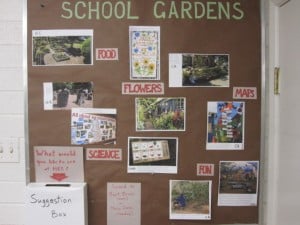 Another update to the school garden!
Another update to the school garden!
 Our compost bin made out of pallets tied together, with the original school garden in the background.
Our compost bin made out of pallets tied together, with the original school garden in the background.
How about the choreography of those two pickaxers? They’re digging up a bed for pole beans next spring, at the base of this 15′ retaining wall, which has a chain link fence on top, so that allows for a 20′ trellis altogether. How high will beanstalks grow?
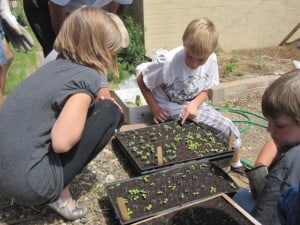 Checking out the progress of recently planted seeds. Watch them grow day by day.
Checking out the progress of recently planted seeds. Watch them grow day by day.
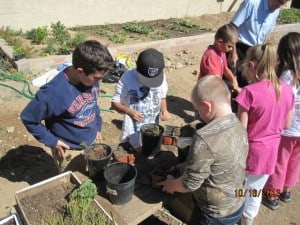 Transplanting time! Learning how to carefully move the fragile seedlings into a larger container so it can continue to grow.
Transplanting time! Learning how to carefully move the fragile seedlings into a larger container so it can continue to grow.
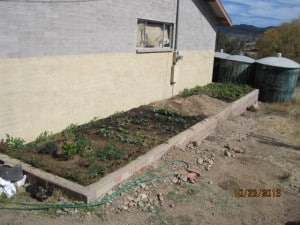 The original school garden growing some fresh veggies once again!
The original school garden growing some fresh veggies once again!
We are sharing an article that we’ve written for magazine publication and has been in the October 2013 issue of Acres USA as well as the Fall 2013 edition of Small Farmer’s Journal. Compost is one of the foundational cornerstones of any successful garden, but has been over-thought and made much too complex by people wanting to make it “faster” or sell you some piece of equipment or machinery to make it “better”. It really is simple to make and doesn’t take any equipment, only needing time to accomplish. After all, who turns and works the compost in nature?
This is about our experiences and what we’ve learned from about 15 years of composting. Enjoy!
What We’ve Learned from Compost
Having been gardening for 15 years and composting for almost as long, we quickly realized that with our climate and native soils, improving the soil’s health and quality were one of the most important things we could do to help our garden. We are located in North-central Arizona, which is a semi-arid high grassland environment. Historically there would be 18 – 20 inches of moisture per year, but we have been lucky to see 10 – 12 inches in a good year over the past 20 years. There is almost always a south-westerly breeze which pulls moisture from any unprotected ground. The soils are really varied in structure with many different types in close proximity to each other. It is not uncommon to have a good productive soil with a caliche or high sandy soil within 20 – 50 feet. Our garden is a good sandy loam, with decomposed granite about 30 feet to the east and a heavy clay caliche soil 20 feet to the west.
Good, aged compost has helped us build the health and fertility of our soil and overcome many of the challenges we face in our garden. It improves the soil structure, brings the micro nutrients and biological life to the soil, along with earthworms and larger soil dwellers. Mulching the compost helps to retain needed moisture and brings the soil moisture level from about 2 inches down to the surface of the soil/mulch interface. We use a combination of straw and wood chips for our mulch.
There is much we have learned that we have applied to our approach in creating great compost, along with observations and education we have sought out along the way. We are happy to share some of our experiences and knowledge about compost.
We don’t turn our compost, partly from being busy and not wanting to invest in machinery or equipment, also partly from research, reading and talking with those who have learned how to create some incredibly rich, earthy compost that looks like highly fertile soil. Most compost tumblers are too small for our needs and a tractor or turning equipment is an expensive purchase for the occasional use.
Our compost piles will age for at least a year before being added to the garden. We have learned that the slow aging is more beneficial to the decomposition process as well as not losing nearly as much nitrogen to off-gassing as happens with the hot and fast methods. Another benefit is the decomposition is much more thorough, destroying weed seeds, pathogens and any unwanted chemicals much better in a slower composting setup. In our climate, we need to water our compost occasionally to keep it going. This is easy to gauge, as the rich earthy smell goes away when the moisture level drops. We water about every 2 weeks on average during warmer weather.
(Cautionary note for those that use city water with chlorine in it: chlorinated water will kill the micro-organisms in the compost and soil that you are working to help! If you have chlorinated water, either fill buckets and let them sit overnight to off-gas the chlorine or buy a chlorine filter that attaches to the garden hose to remove it. Thanks to Marguerite from IL for pointing this out!)
In our research and education of how to make great compost, we consistently saw traditional, proven methods from different countries, climates and approaches that worked. Many of them were very similar, adjusted to adapt to the particular environments of where they were used. The French intensive method used 3 feet of fresh horse manure and straw to heat the cold frames over the winter in Paris, then were pulled out and added to the compost piles to finish decomposing. In the fall the aged compost was added back to the growing beds for the upcoming winter. The Russian dacha gardening tradition shows how continuous composting and mulching with wood chips will improve the soil, overcoming both heavy winters in the north and drought conditions in the south.
Another thing that we found is that European traditions and older American traditions applied compost thickly, about 3 – 4 inches at a minimum, while modern gardening applies it rather thinly – like expensive imported marmalade on toast – and then wonder why they don’t get the results they expect.
After the year of aging and decomposing, our compost looks and smells like rich dark soil. This is especially pleasing to see in comparison to our pale tan native soils! Once we apply it to the garden beds, we mulch it with several inches of straw, watered well to keep it in place. Recently we have begun experimenting with wood chips as mulch, with good results. The wood chips help retain and gain moisture better than the straw, with the added benefit of attracting earthworms faster. The wood chips act like a layer of permeable insulation, attracting the cooler and moist early morning air that sheds its water when it meets the warmer temperature of the soil. This moisture travels into the soil and is retained. It is surprising to see and feel how moist the soil is under 2 – 3 inches of wood chip mulch when there has been no rainfall or drip irrigation at all!
Our approach to making the best compost possible is to combine or “stack” techniques, similar to the bio-tech industry, but it is much more effective with no worries about future side-effects! We will walk you through the different techniques we use and why we use them.
We have used straw bales as the container for our compost system for years, but have recently started using shipping pallets to more effectively utilize the composting area. The pallets are almost 3 times as tall as the straw bales and will give more compost in the same footprint. Wood chips are put down first, about 3 – 4 inches thick. These help retain moisture at the bottom of the pile before it seeps into the soil, as well as helping to attract earthworms and adding nutrients as they break down. We will scatter wood chips throughout the pile as we add horse manure. The nitrogen of the manure helps in the breakdown of the lignin in the wood chips, creating richer and more fertile compost.
Our two horses provide the bulk of the manure, along with the occasional load of cow manure. We are careful to get our cow manure from non-feedlot sources to avoid any contamination from antibiotics, glyphosate or industrial chemicals. This has supplied enough finished compost for our 14 thirty foot long raised bed garden that is our home and trial garden for our heirloom seed business. We apply compost twice a year, mid fall and early spring.
Straw is used to mulch the top of the pile and provides aeration as more manure is added to the top. About 1 – 2 inches of straw is added across the top about every two feet of depth. This is continued as the pile grows in height. As the straw bales that make up other bins start to fall apart, they are added to the new piles.
Milk is diluted 50/50 and sprayed on the pile to help feed the microorganisms and jump starts the decomposition process. The amino acids, proteins, enzymes and natural sugars that make milk a food for humans and animals are the same ingredients in nurturing healthy communities of microbes, fungi and beneficials in compost and garden soil. Raw milk is the best, as it hasn’t been exposed to heat that alters the components in milk that provide a perfect food for the soil and plants, but any milk will work. Using milk on crops and soils is an ancient technique that has been lost to modern industrial agriculture.
Molasses adds readily available sugars to the compost that will skyrocket the microbial activity, with the addition of needed mineral content. We use one cup of molasses to a gallon of water and spray onto the pile once it is about 1 – 2 feet tall.
Coffee grounds are added routinely as the pile builds to help with moisture retention and buffer our alkaline soils. Traditionally, coffee grounds were seen as an acidic addition but recent research shows that coffee grounds act more as a buffer, moderating either an acidic or alkaline pH toward a more neutral one. In arid regions coffee grounds can be added up to 25% by volume of the pile. They are a good nitrogen source to help keep the decomposition going as well as being a natural earthworm attractant! Sourcing the coffee grounds comes from local coffee houses, restaurants, Starbucks, etc.
Hardwood lump charcoal or Bio-Char is added as the pile grows to help the compost in many ways. The most obvious benefit is to add carbon to the soil. Charcoal has a lifetime benefit of several hundred years, as shown by Brazilian university studies on the Amazonian “Terra Preta” sites in the rainforest. It must be hardwood lump charcoal and not briquettes, which are processed with chemical fire accelerators, sawdust and other industrial waste. We like to crush it to about the size of a grain of corn to increase its surface area and effectiveness.
Charcoal acts like a sponge for the first 6 months or so, absorbing minerals and nutrients from the surrounding soil or compost while it “charges” or “activates”. After that it becomes an active beneficial component of the soil, providing housing and food sources for the microbial communities. Mycorrhizal Fungi will colonize charcoal and help to monitor the surrounding soil health, moving nutrients around as needed by plants. It was previously thought that mycorrhizae would only colonize the roots of plants, but it has been found that they will also inhabit charcoal. This will help them live throughout a winter when little root life or activity is present. The charcoal is sourced in 40 pound bags from buying clubs such as Costco or Sam’s Club, and can be obtained in larger quantities directly from the manufacturer.
Trace minerals are added such as Azomite or Elemite to increase the available mineral and trace elements that are often low in today’s feed. This helps the decomposition of the pile, is absorbed in the charcoal and carries over to help feed the garden soil.
Once the compost pile is at the top of the bin, we cover it with a generous layer of straw and build a new bin. Then we pretty much ignore the active pile except for watering when it needs it. Every couple of months we check the pile to see how it is progressing, and see how much it has started to drop in height. Once the pile is finished it will have dropped about 1/4 to 1/3 of its original height.
This system has evolved over several years to the present one and has continually produced better and better compost. This approach may sound like a lot of work, but with the system set up there is very little additional work after cleaning the horse pens. We usually get a full wheelbarrow of fresh manure every other day, and we rotate the addition of minerals, charcoal and wood chips on top of the wheelbarrow load which is then dumped onto the pile, putting the additions underneath the load. Once we have about 2 feet above the last straw layer, we add a few inches of straw. The scent of the active pile is that of a handful of rich fertile earth, so we gauge when to water when we can’t “smell the earth” as we walk by. The additional time needed to add to the nutrients range from the time it takes to add a couple of shovelfuls of wood chips or a scoop of Elemite to the wheelbarrow, to a couple of minutes to crush a few handfuls of charcoal.
No matter what your scale, from backyard home gardener to small acreage, these concepts can be scaled up or down to suit your particular needs and animals. Look to your neighborhood or community for feedstock and supplies for the compost pile. Most horse owners will be happy to give away their excess manure, as most do not compost it and it becomes a waste management issue. Some farms will have excess straw or broken bales that are not useful for them but would be excellent feed for your compost pile.
Good composting – like much of good agriculture – takes a certain amount of patience and observation, letting Mother Nature work her miracles on her schedule. Think about how nature decomposes and composts leaf litter in the forest or grasses in the pasture, they aren’t “done” in 30 to 60 days! Once the cycle is established, you will always have some great compost becoming available for the next feeding of your garden soil.
We are constantly talking about and promoting local, sustainable agriculture and the power of an individual’s choice. Many of the things that are going right in our world of agriculture, food, nutrition and health are the direct result of the intersection of local agriculture and an individual’s choice. One such example is the local Yavapai County Farm to School program that is in the beginning stages as a result of Paradigm Permaculture Coalition’s work.
Here is the press release for their work and first fundraiser, to be held this October 18th and 19th. We are pleased to share this with everyone as an invitation to help this particular program, but also to be inspired and invited to work within your local community to create something similar!
Dear Northern and Central Arizona Friends and Customers:
We are excited to be involved with a new grass-roots organization based right here in Yavapai County, the Paradigm Permaculture Coalition with the goal of bringing a Farm to School program to Yavapai County. Getting fresh, local foods into our schools here and across the nation is important in growing the next generation. We wanted to share with you more about this organization and upcoming events in October that we hope you will support.
History
Farm to School is a nationally recognized and USDA supported program with its inception in 1996-1997. A Farm to School initiative in Yavapai County was seeded in 2012 by a group of local educators and concerned citizens. The Yavapai County Farm to School Grant Advisory Committee applied for the 2012-2013 USDA Farm to School Planning Grant. In 2013, this group of invested partners grew to include Quad-City school districts, local agencies, and non-profits that are in alignment with providing nutrition education, access to fresh local produce for school meal programs, and hands-on gardening activities for school children. The committee applied for the 2013-2014 Planning Grant and will be notified in October if a recipient. The outcome of these efforts was the founding of Paradigm Permaculture Coalition. We are a 501c-3 in partnership with Cornucopia Community Advocates located in Sedona.
Mission & Vision
Paradigm Permaculture Coalition is an educational organization that inspires regenerative living practices in the desert southwest by promoting locally based agriculture through education, community outreach and networking. The term Permaculture was coined over 25 years ago by Bill Mollison and David Holmgren, as a “Perennial Agriculture for Human Settlements” or a conjunction of “permanent-culture, permanent-agriculture”. This is a technology that mimics eco-systems and therefore, society via a system of zones or guilds.
We envision healthy relationships, happy hearts, and empowered people through the lens of permaculture principles of: care of the earth, care of people, and a fair share for all. These actions encourage abundant growth and distribution of local and regional food, provide experiential education opportunities, and enrich local economies that nourish our communities for future generations.
Get Involved: Farm to Table Fundraiser
Our inaugural event will celebrate National Farm to School Month while informing parents, local educators, administrators, businesses and government officials through the engagement of an experiential education field day and ‘Cultural Connections through Local Food’ fun-raising event.
Mark your calendars for October 18th and 19th, 2013. Friday evening fun-raiser will feature local foods dinner, keynote speakers, multi-media presentations, silent auction and raffle. Saturday’s field day will include a visit to the Prescott Farmers Market, a tour of a local farm, and a luncheon with Q & A Farm to School Panel. These comprehensive groups of speakers are instrumental in their own Southwest communities, working toward Farm to School efforts. They offer us valuable information to guide our initiative in the planning and implementation for Yavapai County.
Friday, October 18, 2013 5:30 pm to 9:00 pm
Cultural Connections through Local Food – Yavapai County Farm to School Fundraiser
This fun filled evening will feature informative agricultural presentations by speakers from the Dine’ and Pima Indian Tribes, multi-media presentation on Farm to School, silent auction and raffle, with local foods dinner. $20/per ticket, a portion of which is tax-deductable. All proceeds go toward the successful development of a Farm to School program in Yavapai County. Register for the Yavapai County Farm to School Fundraiser here!
Saturday, October 19, 2013 8:00 am to 3:00 pm
Educational Field Day
To include a visit to the Prescott Farmers Market, a tour of Mortimer Family Farm in Dewey, Chino Valley Farms in Chino Valley and a luncheon buffet with Q & A Farm to School Panel. This comprehensive group of speakers is instrumental in their own Southwest communities, developing and enhancing Farm to School programs. The panel will also include individuals working in our local school districts and Health Department to address food safety issues. They offer us valuable information to guide our initiative in the planning and implementation for Yavapai County. Register for the Educational Field Day here!
Thank you for supporting this project, please forward this email to your friends and neighbors to help spread the word!
The Slow Food Southwest regional meeting was held in Chino Valley, AZ on June 8 and 9, 2013 with members from several Slow Food chapters including Phoenix, Prescott, Santa Fe, Southern Arizona and the Navajo Churro Lamb Presidia. In addition, Slow Food USA was present with Richard McCarthy, Executive Director and Aimee Thunberg, Associate Director of Communications.
The meeting was held at the Prescott chapter leader’s house, Molly Beverly. Regional and seasonal dishes were prepared and brought to the meeting, or cooked at the event. Several fermented salsas were offered as starters, with a wide range of dishes for the dinner and next day’s Sunday brunch.
Richard McCarthy, the new Executive Director for Slow Food USA opened the meeting with a thoughtful and honest overview of Slow Food’s successes and challenges that have come from its growth in the past several years. He then turned to look at the future and what he and the board have for the vision of Slow Food in the United States. There are some great things that are set to appear on the horizon in the next few months!
After the meeting finished, dinner was prepared by the Prescott chapter while everyone enjoyed getting to know each other. New friendships and partnerships were formed over some incredibly tasty food, along with a lot of laughter and joking. At our table the two Navajo representatives demonstrated that they have a seriously funny side to them that is both creative and has stamina as we were hooting and hollering for well over an hour! Several people from the other table came over to see what all the noise was about, and wound up staying to enjoy the good times.
The next morning started with an indescribably delicious Sunday brunch, after which we finished up the meeting. A lot of networking happened both days, with a result that the Southwest chapters are looking forward to working much more closely together to share and spread the word of how wonderful Slow Food is.
Enjoy the video and overview of the Southwest Regional meeting!
Today’s commercial wheat – a semi-dwarf, high-yield type – is causing many people to be sick. Gluten intolerance or celiac disease has skyrocketed since the 1970s and shows no sign of slowing down. A decade ago, gluten intolerance levels were at 1 in 2,500 worldwide. Today, it’s at 1 in 133! What has happened to the grain that has fed us for thousands of years is inedible for an increasing number of people? So what has happened? Why has bread, and by extension many grains, become bad for our health?
First, let’s look at the differences between historical wheat and today’s modern hybrid. Then we’ll look at how the wheat is made into breads and the differences in how we do that today vs. historically. We need this groundwork to establish how and why wheat is not the same grain it once was.
Bread is the “staff of life”, right? Well, it used to be. In fact, archaeologists have uncovered villages that housed the workers building the great Pyramids and found clay pots used to raise and bake ancient Egyptian sourdough bread. This bread was the majority of the diet, along with meat and milk, of the workers. These weren’t office or light duty jobs; these were brutally heavy jobs – moving huge stones over log rollers up dirt ramparts to place them into the pyramid. Bread, milk and meat kept them going for years.
The grains that were used in baking the ancient sourdough are completely different than what we are eating today. Einkorn, spelt, emmer and dinkel are some of the ancient wheat cultivars that our ancestors ate. They are all “covered-wheat” grains, having thick husks around each kernel. The inedible husk must be removed by pounding or milling and then winnowing before the grains can be ground or eaten. Today’s modern wheat is considered to be a “naked-wheat” cultivar, with a much thinner husk that is easier to remove.
The move toward today’s modern wheat began with hybridizing for smaller or dwarf varieties of wheat. Shorter wheat means more of the plant’s energy is put into seed production, increasing yields. This was very successful, producing huge increases in production. Dwarf cultivars are also more resistant to “lodging” or falling over. Lodging occurs when the stalks are too long for the plant’s roots, the stalk falls over (lodges) and rots. Heavy applications of nitrogen fertilizer, common in commercial agriculture, only make the lodging problem worse. The hybrid dwarf varieties were much less susceptible to lodging, allowing excess nitrogen to be applied without losing too much of the wheat crop.
Happy with the increased production of the hybridized dwarf wheat, plant breeders began more hybridization experiments starting in the early 1960s. Extensive hybridization research, testing and experimentation went on, all with the objective of increasing the yields wheat produced. Repetitive back-crossing and crossing with foreign grass species were just two of several techniques used. What happened was a drastic increase in the production capability of the dwarf super-hybridized wheat. Unfortunately, the issue of digestibility was never examined. Another result of the hybridizations is that gluten levels increased in the new wheat, a good thing for making tall, fluffy breads that are appealing to consumers.
The experimentation didn’t stop there however. In 2003 BASF, the chemical company, introduced Clearfield wheat, which is tolerant to their proprietary herbicide Beyond, much like Roundup Ready Corn is tolerant of glyphosate. They proudly proclaim that the wheat is not the product of genetic engineering, but of “enhanced traditional plant breeding” methods. What, exactly, are these enhanced methods that allows a plant to resist a persistent herbicide?
The technique is called “chemical mutagenesis” and might be worse than GMO engineering. Using a highly toxic chemical – sodium azide – as well as gamma and x-ray radiation, the exposed wheat embryo mutates. After further experimentation, testing and development, Clearfield wheat emerges and is tolerant of the Beyond herbicide. Clearfield is now supplied in 20 varieties and nearly a million acres are planted with it in the US and Canada.
So what we are now eating is a super-hybridized, chemically and radiologically mutated wheat. It’s no wonder we are having issues with digestion and allergic reactions that are becoming more common and more severe. Not all of the wheat that is commercially available is from Clearfield wheat, but more and more is coming onto the market. The rest of the wheat is from the super-hybridized semi-dwarf varieties.
Now that we see the wheat we’ve been eating is different than what has fed us for a long time, let’s look at how bread is made today as compared to the past.
Traditionally bread was made with a slow rise sourdough method, using native yeast from the air to raise the dough. Sourdough is a partnership between specific yeast and bacteria that support each other and make bread rise and develops the unique flavors. In the Egyptian example, leftover dough from the previous batch was added into the current batch of water and whole wheat flour, mixed and kneaded well and set out to rise for a day in terra cotta pots shaped much like flower pots we are familiar with today. The next morning, the pots were put into the oven and baked into the bread which fed the pyramid workers. This pretty much describes how bread has been made for several thousands of years, all over the world.
Today’s bread is made with fast-rising yeast that has been cultured specially to raise bread dough faster and higher than any sourdough can. The wheat is milled to remove the outer layers of wheat bran and wheat germ, leaving only the starchy endosperm or white flour that we are all familiar with. Some of the nutrients that were removed with the bran and germ are added in the “enriching” process, where iron and synthetic B vitamins such as thiamin, riboflavin, niacin and folic acid are added back in. Other agents are added to the dough which keeps the bread fresh and pliable for a longer period of time. The bread dough is mixed and kneaded, then left to rise for an hour or two and baked.
The two major differences in these breads are the flour and the method of rising used. The flour in the sourdough bread is whole wheat, meaning the entire kernel of wheat is milled into flour. The white flour is stripped of most of its nutrients; with a few synthetic vitamins added back in after milling. The rising methods and times differ greatly, with the sourdough having time to break down some of the proteins and amino acids that are indigestible initially. The long ferment and rise of the sourdough, often more than 24 hours, allow the yeast and bacteria to make the resulting bread more nutritious and digestible for us.
So now what? Now that we know the commercial wheat and breads of today aren’t as healthy or nutritious for us as those our parents and grandparents ate, what are our choices? Some people are so affected by wheat that they have to avoid it altogether, while others find they feel better once they are off of it for 30 days or more, and then slowly re-introduce it back into their diets. Most find that avoiding modern wheat and sourcing ancient grains, preparing them in the older, slower methods keeps the digestive systems happy. Learning to make sourdough breads with long fermentation and rise times, along with soaking or sprouting grains will make these foods easier to digest and tastier as well.
One of the directions we have been working on is to provide the home gardener and small scale grower with grains that can be grown at home and prepared without milling equipment. The White Sonora Wheat is the grain we’ve started with, helping to re-introduce this heirloom and almost lost variety of wheat back to the Southwest, and the rest of the country. It has a papery husk that is easily hulled, has lower gluten content than today’s hybrid wheat and is well adapted to harsh climates. You can see other choices for the home grower in our Grains department.
In a story that is very much like the rise of industrial, commercial convenience foods we are seeing that the traditional grains and methods of making our daily bread is much more healthy, nutritious and tasty than the modern methods. To our surprise, many people are seeing that sourcing long fermented sourdoughs are easier to do and baking their own bread is not nearly as hard we we’ve been led to believe.
Brian Halweil shares an important message about how food can and does change the world for the better. This short TED talk reminded me of my days in college and reading the same Paul Ehrlich title. Sometimes as individuals we can be overwhelmed with facts and figures, doom and gloom. In order to make positive changes in the world and home, we each need to take one step at a time. We hope this video inspires you to do just that!
Seeds – The Buried Beginnings of Food
“Seeds hold the potential for everything, the beginning and the end and the beginning all over again. Seeds are the building blocks of every meal we eat; all our fruits and vegetables, all our grains, plus the meat and milk that’s raised on grass and grain.”
Simran Sethi is an award-winning journalist, strategist & educator who teaches & reports on sustainability, environmentalism & social media for social change. Simran is dedicated to a redefinition of environmentalism that uses innovative forms of engagement & includes voices from the prairie, urban core & global community. She recently gave an inspiring presentation at TEDx Manhattan on Seeds – The Buried Beginnings of Food where she shared how much seeds really do matter to all of us, no matter where we live or what we do as a profession.
After showing how few varieties of edible plants we cultivate for our food – about 150 out of more than 80,000 – she goes on to explain the vast majority of humankinds food comes from just about 30 species. In America, over half of our daily calories come from just 4 foods – rice, corn, wheat and potatoes! We are seeing the results of a gradual shrinking in the variety of our food supply over the past 50 years, what is known as a loss of agricultural biodiversity. This is the unintended consequence of a system that was originally intended to increase productivity and feed the world – large-scale industrialized agriculture.
Moving on, she shows the staggering loss of the cultivated foods we used to depend on – by some estimations a 75% loss of food varieties that have disappeared since 1900. Combined with this is the alarming consolidations in the ownership of seeds, essentially seed monopolies. Three corporations now account for over half of the global commercial seeds market today. This includes hybrids and GMOs, both of which can’t be saved and re-planted for the next year. With this model, seeds have become non-renewable resources, inventions created by companies that farmers are required to buy from year after year.
One company now controls the genetics of nearly 90% of the corn, cotton and soybeans grown in the United States. That same company bought the world’s largest developer and grower of vegetable seeds in 2005. As she so emphatically states,
“Monopolies are hideous with our cellphones, we know this! They are disastrous with food, because food and seeds aren’t just any other commodity.”
Watch her powerful presentation, learn a few things and become inspired to take a more active part in your food!
One hundred years ago, the name Luther Burbank was instantly recognized in a way that we are not familiar with today. Beginning in 1873 and continuing until 1932, 6 years after his death, more than 800 new varieties of vegetables, fruits, flowers, nuts and grains were bred, stabilized and introduced by him. He was much better known than the common term “Rock Star” today, because what he did transcended social, financial and political boundaries.
An American botanist, horticulturist and pioneering agricultural scientist, Luther’s name is often entangled with the emergence of bio-engineering and the patenting of plant life. This is truly unfair, as his work was dedicated to expanding the grower’s options, giving them improved varieties that grew, looked and tasted better and were more affordable to the consumer than what was available at the time. There were few thoughts of patenting the plants that he developed, as the Plant Patent Act was passed in 1930, 4 years after his death. He was more interested in getting the new varieties out into the world and into the hands of the growers and gardeners.
The number of varieties that he introduced is enormous, from his first discovery- the potato – to blackberries, plums, walnuts, quinces, lilies, roses, rhubarbs, daisies, dahlias, poppies, the plumcot or pluot, amaryllis, spineless cacti, peas, primroses, cherries, corn, artichokes, sunflowers, the New Burbank Early tomato, day lilies, Elephant garlic, strawberries, thornless blackberries, amaranth, zinnias, nectarines and peaches.
One of his earliest developments was the blight-resistant potato that was exported to Ireland and helped end the famine there. We know it today as the Burbank Russet that is the most commonly grown and eaten potato today.
He transformed 19th and early 20th Century California from a primarily wheat producing state to varied types of fruits. Europe changed from an exporter to a net importer of fruit, especially California fruit, due in large part to Burbank’s fruit breeding and the climate of California.
Other achievements included spineless cacti to help arid Western ranchers provide another, more reliable source of food for their cattle in harsh conditions. The stone-free plums were his and even the now-common bright crimson California poppy that is very well known was originally orange.
The Luther Burbank Home and Gardens is a museum of his home and workspaces where he did much of his thinking and plant breeding. He is buried on the property as per his final wishes to be part of the landscape where he lived. This is the first house he lived in when he moved to Santa Rosa. The second and larger house that he built with the income from an overseas seed sale is no longer standing.
We took a tour of the home and grounds last fall. The existing grounds are only a portion of the original gardens, as much of the land has been sold off in later years. It is impressive to see what was accomplished here.
We took a lot of photos during our visit and wanted to share the following photo essay with you!
Cindy and Eileen are standing at the back entrance to the home.
The home with its unique greenhouse where much of the experimental breeding was conducted. The trees are all mature and very large.
The 2 story house was considered to be large in its day, and is a very comfortable size even by today’s standards. We were able to tour the ground floor and see how it has been maintained.
The guestbook shows a number of famous and influential visitors, from Henry Ford and Thomas Edison to foreign heads of state and agricultural ambassadors from around the world.
Luther designed his greenhouse, using flat glass panels but creating a rounded structure. The panels are overlapped like shingles and held in place with wooden cross-pieces. The loose set brick floor retains heat and allows water to flow through. There is a fireplace at one end to heat it through colder winter nights. The current configuration has been changed from the original, Elizabeth shortened it after a fire.
Dwarf lemon tree with lemons in mid September.
More dwarf citrus.
Cindy with Shasta Daisies and her favorite flower, the sunflower. There are rows on rows of these beds, each with different species of flowers and most of them are marked.
Eileen in front of a trumpet bush.
There were several milkweed pods ready to burst and send their silky fine flossy seeds into the world.
This is what a handful of milkweed floss will yield, only a few seeds! This will be part of the challenge when we help to harvest the milkweed seeds at Painted Lady Vineyards Milkweed Project this fall!
And away they go! There was a breeze during our visit, so they blew away quickly.
Spineless Cacti.
Colorful Rudbeckia.
Monarch luncheon.
Bee feasting on Dahlia pollen.
A fuschia Dahlia.
Bees having a party!
Cactus Dahlia.
“You have to live a life without fear; and to be fearless, you have to have a very clear conscience that guides you on a daily basis. If you are fully aware of doing the right thing everyday, there is no power on earth that can make you afraid.” ~ Vandana Shiva, Mt. Allison University, New Brunswick Feb. 26, 2012
“We live today where creating fear is the political governing style today. Cultivating fearlessness I think is one of the most important trainings of democracy and citizen freedom.”
We share this short video of Vandana Shiva telling her story of the struggle to preserve heirloom seeds in her native India from the wonderful folks at The Perennial Plate.
Engineering Salt, Sugar and Fat to Create Food Addiction
“Today, one in three adults is considered clinically obese, along with one in five kids, and 24 million Americans are afflicted by type 2 diabetes, often caused by poor diet, with another 79 million people having pre-diabetes. Even gout, a painful form of arthritis once known as “the rich man’s disease” for its associations with gluttony, now afflicts eight million Americans.”
-Michael Moss in The Extraordinary Science of Addictive Junk Food
How did we reach this stage of poor health as a nation? The answer may surprise and anger you. As with most complex issues, the answer is not as simple as many talking heads in the media and nightly news would have us believe. It isn’t just a matter of willpower, or knowledge, or education, or alternatives to the junk food that is, quite literally, killing us. The answer is far deeper, wider reaching and more sinister.
Most processed foods these days are “optimized”, or engineered for better sensory perceptions that drive us to eat more. These sensory perceptions include but are not limited to the physical appearance, packaging, shape, mouth feel, taste and array of flavors, aftertaste, smell and satisfaction of a food. One of the most important factors that are considered is the strength of the urge for a second bite, sip or swallow, or a third.
Everyday people spend hours in tasting rooms where they touch, feel, sip, smell, swirl and taste whatever product is being optimized. Their opinions are fed through a very sophisticated program that not only produces an optimized formulation for the food in question, but also addresses marketing concerns such as colors and packaging. All of this is done to gain more “stomach share”- the amount of processed food that a consumer will eat from a certain company. These are not small concerns in an industry that measures stomach share in the billions of dollars annually.
The Holy Grail for food companies is what is termed the “bliss point”, that spot where consumers like a product the most, but are not satisfied enough with the flavor combination to stop eating it. Foods and drinks cannot be too flavorful, as consumers quickly get bored with them. The brain is quickly overwhelmed with big, intense and distinct flavors and shuts down the “want more” portion, thus stopping eating.
This has become one of the major guiding principles of the processed food industry. The biggest players owe their success to very complex and secret formulas that pique the taste buds but don’t have a distinct, intense flavor that shuts down the desire for more. This is the science of engineering addictive junk food at its most focused and intense.
For example, Frito-Lay employs about 500 chemists, psychologists and technicians to conduct research that cost up to $30 million a year that focuses on questions of crunch, mouth feel and aroma for each of their product lines. One of their tools simulates a chewing mouth to test and perfect their chips, like the perfect “break point”; people crave chips that crunch at about four pounds of pressure per square inch. You just can’t make stuff like this up!
With market shares reaching multiple billions of dollars, highly aggressive marketing tactics such as Coca-Cola make twisted sense. Their goal was simple; outsell every other beverage that people drink, including milk and water! From this goal they developed one question for the marketing division – “How can we drive more ounces into more bodies more often?” This explains the door-to-door sales of Coke to Brazilians living in slums and frontier shanty-towns.
With all of this high technology, psychological and physiological research running into hundreds of millions of dollars, strategic placements and extremely focused marketing campaigns all supporting highly addictive processed foods, what chance do we as everyday people have?
Somewhat surprisingly, we actually have a pretty good chance. Alternative research has shown that people can “recover” from their junk food addictions simply by abstaining from them for a period of time. Eating normal meals, eliminating or restricting snacking on junk food, or replacing that food with real, healthy food recalibrates our taste buds. Skipping meals is one of the leading causes of increased junk food intake, not by desire but simply because of convenience. Snacking on fresh vegetables such as carrots, apple slices, celery or such that provides the crunch that we have come to desire helps ease us out of the salt/sugar/fat cravings and into appreciation of new tastes and flavors that have been lost as we overload our taste buds with junk processed foods. The brain has a chance to realize that the food being eaten has nutritional content and can once again establish a reasonable signal of when the stomach is “full”. It is no longer tricked into over-eating multiple times a day.
Once a recovery period of a couple of weeks to a month had been established, most people found the tastes of the same junk food they previously had highly enjoyed were too salty, fatty or sweet and lacked the real flavors that they had re-discovered and come to appreciate. They also had pleasant side effects of increased concentration, higher energy that lasted throughout the day, decreased weight, blood pressure and headaches, among many others.
The Extraordinary Science of Addictive Junk Food – NYTimes.com
Your Garden is Chemical-Free, Are Your Seeds?
There is a groundswell among home gardeners looking to grow their gardens in a less chemically intensive and more biologically responsible way. They spend hours reading and researching the best ways to build the health and fertility of their soils, improve the microbial communities in the soil and attract earthworms and beneficial insects and pollinators. The appearance of more earthworms, a new species of butterfly or pollinating moth is cause for celebration.
Seeds are a high priority for these gardeners. The purity, quality and provenance are paramount. After all the work and care that goes into the soil and preparation, they rightly want the best and highest quality seeds possible.
Surprisingly, this is exactly where the home gardener and small scale grower may be getting shorted on quality. Growing for seed as opposed to growing for food has its own unique challenges. For a plant to set seed it must reach full maturity, set flowers and produce seed. This takes much longer than a plant grown for food which is usually harvested at a much younger stage, succulent and tender. Producing seed exposes the plant to a whole host of insects and diseases that younger plants may not experience, due to the phytochemical changes that take place as the plant matures sexually in order to reproduce.
Margaret Roach wrote a great opinion piece in a recent New York Times Sunday Review:
“In my own vegetable beds I use no chemical heroics, and yet I had been using some conventionally produced seed that is often coddled and adapted to a life of “high inputs” that it won’t get from me or from an increasing number of other chemical-averse home gardeners.
That packet of seed may not grow as well in my garden as one that wasn’t grown with chemicals, and it also probably contributed to upstream pollution.”
Agricultural regulatory agencies allow an expanded use of petro-chemical pesticides, fungicides and fertilizers if a grower specifically grows for seed production and not food production. Many large-scale seed growers take advantage of this loophole, with the unintended consequence of creating a population of seeds that have become dependent on high-input, chemically intensive agriculture that many home gardeners are moving away from.
This has been ongoing for several decades now and is just being discovered as more and more gardeners and small scale agriculturalists are growing with less chemically intensive methods and are looking for sources of seed that are in line with their vision.
The end result of using seed grown under these conditions is that they usually don’t perform as well. They don’t germinate as strongly, are slower to put on growth, develop fewer flowers and are much more pest, disease and weather susceptible. In short, they simply aren’t as strong and resilient as those seeds grown in more biologically active soil with little to no chemical inputs.
While modern chemical agriculture initially looks very promising with better growth and increased yields, it is always discovered that plants grown with amply available macro-nutrients afforded by the chemical fertilizers become lazy and lose the ability to work for their nutrition, growing ever more dependent on the applied fertilizers for food and pesticides to control the insect populations.
The solution to these issues is to find seed sources that concentrate on growing their seed in a natural and low-input manner. These are often smaller, family-owned companies that are happy to answer questions on how their seeds are grown. They know the story of the seed they offer and willingly share it. Patronizing these companies only helps to strengthen the entire system by rewarding those that are congruent with the natural order of agriculture.
By all accounts, the FDA is a miserable failure for food safety.
Many of us remember the national food safety nightmare – a listeria outbreak in cantaloupes from around Rocky Ford, CO – in the summer of 2011. All in all, there were 147 illnesses and 33 deaths, making this incident the most deadly outbreak of food-borne illness in our country since 1924. The farms owners declared bankruptcy later that fall. All of this occurred because of jerry-rigged potato cleaning equipment had been adapted to wash melons in conditions that heavily favored bacterial growth. There were no anti-microbial solutions – such as chlorine – used to kill the bacteria, only water.
As bad as this sounds, it is only the tip of the iceberg. The real tragedy, or crime, depending on how you view it is that not once in its 20-year history had the farm been inspected by the the Food and Drug Administration (FDA), tasked with the oversight of the safety of our food supply. A third-party inspection company was used by the farm, and accepted by the FDA as certifying the safety of the equipment and processes used in its handling systems. In fact, the company had one of its auditors at the farm at the time the first people were being sickened, and gave the processing facility a “superior” rating of 96 percent after a four hour visit.
This, sadly, is not an isolated major food safety incident. There are about 48 million cases of food poisoning each year, according to the Center for Disease Control. These result in more than 3,000 deaths. Affected foods include fresh vegetables and fruits, eggs, meat and cheeses – just about everything we eat! The rate of outbreaks and food recalls has been steadily rising since 2007. In a nutshell, our national food safety record sucks.
Why have these outbreaks increased in numbers and severity? What can be done about it? Let’s address the first question, then we will look at the second one. The Government Accountability Office (GAO) has found that the FDA is riddled with shortcomings, both in the administration and regulation areas. The process it uses for product recalls is ineffective and confusing, it has waffled with the blatent overuse of antibiotics in animal feeding operations, and lacks the manpower to perform the scientific studies required to do its basic job of food and drug safety. When enforcement is attempted it only occurs about half the time and is half-hearted, with fines rarely imposed. It also accepts third-party inspections, which often have serious conflict-of-interest issues alongside questions of the quality of inspections, as shown by the cantaloupe fiasco. Another example is the Iowa based salmonella based recall of over 550 million eggs that led to the first (and only) inspection performed by the FDA, followed by a warning letter threatening “regulatory action”. A month later the company was allowed to resume selling eggs, with no corrective action being confirmed or other inspections performed. Yet another example was the salmonella outbreak in peanut butter in 2007. A plant was missed after an “intensive round of inspections” that was the cause of a second, more deadly salmonella outbreak. When that plant was finally inspected, it was found to have mold on the walls and slime covering the processing equipment.
One of the main reasons for the increased number of outbreaks is the amount of control the food industry has over the FDA. When an industry has enough political power, it uses that power to determine what the FDA will do in response to an issue. Unfortunately, that response is all too often to “do nothing” unless there are enough deaths to attract enough public attention to the issue. In addition to political pull, there is a “revolving door” policy where top industry people go to work at the FDA, sometimes while still drawing a paycheck from their “former” employers. Conflict of interest, anyone? One of the prime examples of this is Michael Taylor, a Monsanto attorney who prepared research on the constitutionality of states determining labeling laws for Monsanto’s bovine growth hormone rBGH. Then, once he had become the FDA’s deputy commissioner for policy, he wrote the guidelines for rBGH labeling policy for the FDA. Not surprisingly, they were in agreement with the research memo he worked on while at Monsanto. This is not an isolated case, either. There are many former and current employees of Federal regulatory agencies who are or were industry executives and vice versa.
Now to address the question of what can be done? Surprisingly, there are several possible movements afoot that might have a positive impact on the state of food safety. The Food Safety Modernization Act of 2011, a very controversial plan that was opposed by many smaller producers and supported by larger ones, may have some keys to this puzzle. It has been delayed with budget issues and has not gone into effect, but grants the FDA the power to prevent repeat offender from continuing to sell their product by revoking their registration. Another proposal by a Connecticut congresswoman would sever the ties of the food industry to inspection agencies. Third-party inspections can be effective if the inspector is not bing paid directly by the company they are inspecting. Some inspection companies have board members who are executives in client companies they monitor. Again, what conflict of interest?
These are all well and good, but can the average person trust them to be effective? Will they measurably improve the quality of the safety of our food? That remains to be seen. In the meantime you can do what has been proven to be extremely effective so many times before. If you are concerned with the safety of your food, do something about it. Take a personal interest and responsibility for what you eat. This means doing some reading and research, asking questions and listening to the answers. You will establish your own “approved list” of food suppliers that you trust and those to stay away from. This will take some work, but probably much less than you think and for a shorter time period than you would initially expect. Once you establish a safe list, you won’t have to research each and every food item you buy, just the new ones that you aren’t familiar with.
Not surprisingly, you will quickly find that the majority of food producers you come to trust are the ones you can get to know. They will be local or regional, with small to medium sized operations. They will answer your questions and your phone calls, not minding that you need some answers. They will offer farm or facility tours, which you should accept. There are already several organizations that help with finding just these sort of companies. We’ve written about several of these, one is FarmPlate, another is Horsepower and yet another is Local Harvest. All of these are online tools to help you do what I just described, find quality and trustworthy sources of good, clean and fair food.
By taking responsibility for your food, you ensure that what you eat is to your standards. You also take that decision process out of the hands and control of a corporation and put it firmly in your grasp. You might be surprised at how the quality and safety of your food improves with much less cost than you expected.
The holidays come early when you work with heirloom seeds, as shipments from growers start arriving in early November and continue as the seeds are harvested, cleaned, dried and shipped to us for packing.
Some of our seeds arrive in cloth bags with hand-written variety descriptions on them, others arrive in large paper bags tied shut and yet all of them clearly show the care and love put into their growing and production. We wanted to give you a short tour of what it is like when seed arrives!
This particular shipment is always accompanied with high anticipation, as it comes to us from one of our growers who is incredibly talented and experienced. Their advice has been invaluable, whether it is in recommending new varieties to offer or catalog suggestions.

Bags of Heirloom Seeds
Each variety is in its own cloth bag with the variety name handwritten on it. They are wrapped in plastic to protect them from possible moisture in shipping. This particular box was a bit smaller this year, as we brought home almost this same amount when we visited our grower this past September.

Heirloom Seed Treasure
When we received the very first shipment of seeds, we were talking about how they resembled bags of treasure. Cindy remarked that this is very much just that- treasure from the past that has been kept alive by people before us that valued these seeds enough to save and preserve them for the future.
That future is now, and we are the recipients of that treasure of knowledge and hard work. This Katanya watermelon is from a woman named Katanya who brought its seeds with her when she immigrated from Russia. It is humbling and thrilling at the same time to hold more than a hundred years of history in a bag in your hands, along with who knows how much future!

Papalo Seed!
Some of the seed is just fun to handle and play with. Papalo is one such variety; an ancient Mexican herb that was largely replaced by Cilantro, a Chinese herb. It is extremely light and feathery, resembling a dandelion seed with its “parachute”. Papalo requires special handling and packaging, as if the seed is broken off of its parachute, the germination suffers drastically. The bag Cindy is holding weighs a couple of pounds at the most.
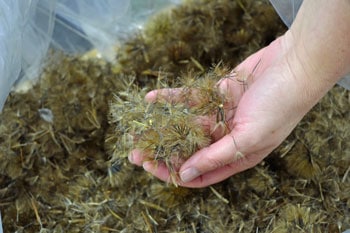
Handful of Papalo
This handful of Papalo has about a hundred seeds, which have to be packed and shipped in small boxes to prevent them being broken in transit. When we do bulk sales on this it is by the number of plants needed, not by weight!

Bag of Heirloom Corn
This package was a new treat for us. It is Oaxan Green Dent corn from one of our newest growers. Oaxan Green Dent makes green corn tamales for the Zapotecs of southern Mexico and a very tasty green masa. They produce everything by hand, even the shucking of the cobs and shelling of the corn kernals.

First Peek of Oaxan Green Dent Corn
Here is what we saw on our first peek into the bag! Very colorful and striking. Very unlike what we are used to seeing as bulk corn.

Oaxan Green Dent Corn
A closer look at its colors. Heirloom corn glamor shot!
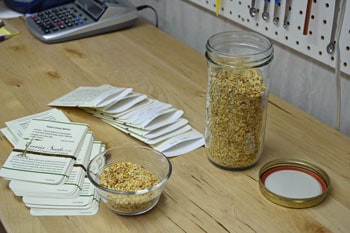
Hand Packing Melrose Pepper Seed
Of course, all of this new seed arriving means there is work to do. Everything we sell is hand packed, every single packet! As each new shipment of seed arrives we re-verify the number of seeds to a packet, then count that number and find a measurement that corresponds to it. We always try to give a bit more seed than advertised, as each packet is packed by measurement, not individually counted. A new shipment of Melrose Pepper is ready to be packed here.
Thanks for joining us, we hope you enjoyed a brief look at what happens when we receive new shipments of heirloom seed!
The Slow Food Terra Madre and Salone del Gusto events are world-famous for their sights, tastes and smells of top-shelf quality foods made in a traditional way. It is exciting to see, taste and contrast flavors from different regions of Italy and across the world with just a few steps and a couple of minutes of your time. Much of this is serious business as artisanal food producers showcase their hard work and experience in creating classical foods.
Not everything and everyone is all about work with no play, however. There is much to see and hear that is fun, unusual and surprising to see amongst the booths that is light hearted and enjoys a laugh with friends, new and old. There were an abundance of children soaking up the sights, aromas and flavors of the Salone with their parents or in groups doing tastings, cooking or creating spice mixes.
Our presentation showcases some of the fun sights we came across during our visit to Slow Food Terra Madre and Salone del Gusto. Enjoy!
We are pleased to present our experiences of the opening ceremony of the 2012 Slow Food Terra Madre conference in Turin, Italy. It was held the evening of October 24 at the Palasport Olimpico, also known as the Palaisozaki, after the Japanese architect’s name – Arata Isozaki. This is in the Santa Rita district of Turin, just east of the Olympic stadium. It was built for the 2006 Olympics and hosted the ice hockey events. With seating for over 12,000, it is an impressive venue!
We arrived early after registering at the main Slow Food event center and waited for the gates to open. We quickly learned to make use of these periods of waiting and not be impatient that things didn’t run on an American schedule. Introducing ourselves, we quickly made some new friends and were once again impressed with the dedication, creativity and just plain genius with which so many people were applying themselves in their search of how to answer Slow Food’s directive of “Good, clean and fair” food for all. This opening ceremony was for and about the international delegates but was open to the public.
Once the gates opened, we checked our luggage into the baggage claim area and made a line for the latest in a long line of cappuccinos (cappuccini in Italian!), as we had been awake for the better part of 30 hours at this point. We had arrived in Milan at 7:30am that day after a combined flight of almost 13 hours, and wouldn’t check into our hotel until after the opening ceremony. A long but exhilarating day!
People were encouraged to dress in their native clothing, and it was a grand sight to see, with the entrance being made coming down the long stairs into the delegates seating area. The surrounding stands were soon filled almost to capacity with the public, who was very enthusiastic. The energy and excitement was contagious and had the whole arena buzzing.
After the opening welcome speech by the Mayor of Turin, the parade of flags commenced. A delegate from each nation present presented their native flag and was seated in honor above the podium. 95 countries were present this year! Afterwards there were many presentations and speeches about the different directions Slow Food has moved, as well as live poetry acted out by Nobel literature prizewinner and playwright Dario Fo, live music by Italian trumpeter, singer, composer and arranger Roy Paci. Both Vandana Shiva and Alice Waters presented their thoughts to thunderous acclaim. The United Nation’s FAO Director-General José Graziano Da Silva gave praise and strength to the Slow Food movement, acknowledging the impact it has had worldwide and noting that governments and advocates for sustainable food are turning to Slow Food for help in writing proposals and drafting legislation.
This was a fine promise of things to come, that was more than fulfilled in the next 4 days!
For more than half of 2010 members of the Department of Justice and Department of Agriculture held investigative hearings around the country on the impacts that Big Ag – industrialized, commercial agriculture – had on the producers that supplied them or used their products. For many of the farmers working under contract to national companies, this was potentially great news. This was a unique opportunity to talk directly with some of the highest-ranking officials in agriculture and justice to tell their story and get some help. The message from Washington seemed to be pretty clear – they were interested to hear how the independent farmers of America were being used and pushed around by Big Ag, and they were not going to allow these practices to continue.
During their tour of more than seven months of 2010, the officials heard from many farmers, ranchers and other producers around the country. They learned of the power and technology concentrations in the seed, pork, cattle, dairy and poultry industries. They looked at the discrepancy between the price consumers pay for food and the price farmers receive for producing it.
Very similar stories were told over and over again from many separate parts of the country of abusive practices across the board in all of the different industries. No matter the industry or what part of the country the meetings were held in, it seemed that the story rarely changed. Contracts, terms and conditions that would make rural Southern sharecropping look pretty reasonable by comparison were the norm. Preferential treatment, grudge punishment for questioning the system and constantly rising costs and tightening requirements are all part and parcel of doing business with Big Ag these days. That doesn’t even begin to take into account the threats of lawsuits or financial punishment that accompanies much of these systems of contracts. In the seed industry, for example, it is common for farmers to have to sign a binding agreement in order to purchase corn, cotton or soy to plant in their fields. They must agree to use only the specified fertilizers, herbicides, pesticides and seeds. They cannot save any of their seeds. Pamphlets are routinely mailed to all of the farmers in a region offering “gifts” as rewards for reporting their neighbors for “breaking contract”. Neighbors are suspicious of each other, even those who have farmed next to each other for several generations.
So, what resulted from all of that travel, all those meetings, all that planning that we, the taxpayers, paid for? Going on two years down the road – not much. The USDA developed legislation that revised and updated the regulation of livestock industries that would prevent the destructive practices that are now common. The Department of Justice initiated an anti-trust investigation into Monsanto and DuPont about their “possible anti-competitive practices in the seed industry.” Monsanto was targeted for its business practices surrounding its Roundup Ready soybean. Information on the DuPont investigation was not released.
The USDA legislation was met with heavy criticism and attack from the House of Representatives, the House Agriculture Committee, the National Cattlemen’s Beef Association and the National Chicken Council, all of which was to be expected as they are funded by special interest groups of the very industries that would be affected by the revised laws. The final straw to the whole process was a rider in the June 2011 House Appropriations Committee funding bill that was was designed to strip the USDA of the funds it needed to finalize and implement the strongest of the proposed rules. By late 2011 the Dept. of Justice, Dept. of Agriculture, the USDA and the administration was in full retreat from the corporate livestock, seed, dairy and poultry lobbies.
The rider passed in November 2011, effectively killing the revisions. Very recently, the Dept. of Justice closed the antitrust investigation into the U.S. seed industry, absolving Monsanto and DuPont of any wrong-doing. The damage done to the very people that the hearings were trying to protect – the producers – is unknown at this point. From the Washington Monthly –
“By documenting the big processing companies’ exploitation of independent farmers, then failing to stop that exploitation and retreating in almost complete silence before entirely predictable resistance from the industry, the administration, for all intents, ended up implicitly condoning these injustices. The message to the processing companies is, after all, absolutely clear: you are free to continue to act as you will.”
Where do we go from here? Several things have been shown to us from these events and actions. One: industry controls government in this country, regardless of what anyone says to the contrary. Sure, there may be examples; they only serve to point out the minute exceptions, not the mainstream. Two: getting away from industry and corporate control of food is in all of our best interests. How do we do that? By continuing to support and actively participate in local, sustainable methods of growing and producing our food. Buy from the farmer’s market, join a CSA from a local grower, get to know who grows your food and how it is produced. Yes, this takes work. The alternative is the recent headline – “To Find Antibiotic Resistant Bacteria, Look to Commercial Pork.” Is that the food system we want and support?
U.S. Closes Antitrust Investigation Into Seed Industry, Monsanto
It will take several other articles and videos to give a more rounded overview of the event, as it is really several events all rolled up into one. We were chosen as International Congress delegates, which was a completely separate event that is held only once every four years and is attended by those chosen for their work in advancing the core tenants of Slow Food – “Good, clean and fair.” To say we were honored to be among the likes of Alice Waters, Vandana Shiva, Carlo Petrini and 650 others is a monumental understatement. On two separate occasions we felt we were in hallowed company. The first was the opening ceremony for the 230 Slow Food USA delegates where Carlo had some remarks that were amazing. I walked up to the front of the room just before the opening ceremony started to get a photo and stood there for a minute looking at everyone getting settled and chatting with their new neighbors. It was both humbling and inspiring to be in the same room with so many talented, dedicated, passionate and brilliant people who are all working at the same goal from so many different angles – good food that is real and honors all who are involved with it. The second time was in the gorgeous theatre that housed the opening ceremony for the International Congress. This theatre was in the renovated Fiat factory that has its own test track on the roof, a huge building in itself. The theatre was red velvet and oak, with all 650 delegates sprinkled throughout. It was the same feelings as with the USA delegates, but on a larger scale; especially when we heard several of the speeches of what other countries were working on or had accomplished.
With that teaser, we present for your enjoyment “A World of Taste – Slow Food Terra Madre/ Salone del Gusto 2012.” This is a short overview of photos and some short video we took while attending the event. This is only a small sampling, so stay tuned for more to come!
The co-founder of Slow Food International, Carlo Petrini took the stage after the opening ceremonies at the Slow Food USA delegate meeting during the 2012 Slow Food Terra Madre and Salone del Gusto conference in Turin, Italy this past October. He gave his remarks to about 230 delegates from all across the USA who are working daily on the core tenants of “Good, clean and fair” food for everyone. It was impressive to see the amount of passion, dedication, talent and genius gathered together in that room, all for the sake of one of our most important yet overlooked foundations of life; food.
Carlo seemed to be impressed as well, with comments like “What you’ve done in America is extraordinary, not just for the USA but for the rest of the world. A Slow Revolution toward respecting food, a deeper appreciation of food that serves as an example for the entire world.” He went on to say that we’ve helped “Achieve the most important thing that Slow Food needs to achieve – given back a holistic sense of food.” We’ve started to show that food is not and never can be a commodity, merchandise, just a price point.
Its story is important – the memory, the people and its history. By reducing food and everything about it to its commodity values of productivity and profit, we are approaching a brink. That brink is the loss of diversity, not only of the varieties of foods that have nourished us for thousands of years, but the loss of human and cultural diversity as well. Those different types of diversities have enabled us to withstand and overcome many different challenges over the millennia, adapting and growing stronger in the process. Without all of those diversities, we are all weakened and more vulnerable to changes, whether expected or unexpected, human or natural caused.
Carlo closed by saying that the people of Slow Food have the holistic vision of the path back to the healthy diversity that will make our food and our communities whole again. Slow Food delegates practice that vision daily, working to strengthen our food connection everywhere we are, every day. Watch the video and see Carlo’s thoughts for yourself!
The Local Food Movement Gets A New Prescription
The local food economy is entering a completely new chapter with such seemingly unlikely partners as St. Joseph Mercy Hospital of Ann Arbor, Michigan. Leading edge, innovative hospitals such as St. Joseph’s are working to incorporate more local, sustainably grown produce into their menus and food systems. Things quickly become complicated due to the sheer amount of food that is prepared and the time needed for prepping. For instance the soup du jour for 600 people is 65 gallons. The ingredients needed in one just day’s vegetable soup would require hours of prepping and chopping, but is supplied by the current food distribution system already pre-washed, sliced, diced or cubed and ready for the cooking process. As an example, the green beans sourced from a local grower – 200 pounds of them – required 8 hours of washing, snipping, stringing and slicing to prep for that day’s evening meal. Even though the food was sustainable, the processing wasn’t as the kitchen isn’t equipped to handle that amount of prep work on a continuous, daily basis.
There is a tremendous enthusiasm and pressure from consumers of all sizes for more local food. These consumers aren’t just the mom and dad at the farmer’s market on Saturday, but are increasingly including the large scale commercial consumers such as hospitals, universities and large businesses that are looking to satisfy their customers and employees desire for better tasting, more healthy, local food. This is a good, or possibly great thing, if it can be handled to benefit everyone in the equation. One of the biggest challenges for local food economies is that the commercial consumers have been set up to take advantage of the industrial food distributors efficiency and convenience. They are the keystones as to why and how large distributors reign supreme in this market. Everything shows up prepped and ready to use – something that isn’t even thought of in the local food model. Granted, there can be some improvements in the commercial consumers kitchens, as most of them do not have any facilities set up for any prepping whatsoever. This can be remedied, but takes dollars, forethought, planning, construction and time to accomplish.
Farmer’s markets are an important piece of building the local food system, but they are still such a small part of the entire US food production – less than 1 percent for the just over 7,000 markets across the country- that significant growth and positive impacts for the legion of local growers can be realized by connecting small and mid-sized local farms with these institutional, commercial consumers in their local communities. Even very small changes in the purchasing patterns of these consumers can have major changes in the local food system, as an average sized hospital’s food budget can easily top $4 million annually. Just 1% of that is $40,000 that would stay in the local food system, making a huge positive impact. A more realistic figure of 2 – 3% purchasing change means $80,000 – $120,000 going into the local grower’s systems. What benefits and opportunities can you see $80,000 having on your local farmer’s market and local food network?
There are a couple of workable solutions to the questions of efficient local food distribution to make life easier for these larger customers. One is a regional food distribution hub, which some models have proven successful and others have failed in different regions of the country. Another is a co-operative system that partners with a smaller, regional food distribution system that is already in place, effectively adding a “local, sustainable food” section to it’s inventory of supplies and services. There are still others that bear examining and evaluating to see if they would work for a particular need or application.
There are a growing number of institutions just like St. Joseph’s who are responding to their customer’s desires and needs by putting their not inconsiderable moral, ethical and financial weight behind new local food initiatives. The market is there, it just needs some evaluating, adjustments and planning to make it happen, with hugely beneficial results for both the growers who can create the relationships and supply the needs as well as the institutional consumers that can broadcast the triumphs of inter-weaving local, healthy, sustainable food into their menus.
Slow Food Terra Madre 2012
Terra Madre Salone del Gusto 2012Here is where we will document our trip to Turin, Italy to attend Slow Food Terra Madre 2012, so watch this Topic/Category for updates. We are International Congress delegates, which is a separate conference at the end of Terra Madre for Slow Food leaders worldwide to discuss the direction of Slow Food globally. It is held every 5 years. This is the first year the International Congress is being held concurrently with Terra Madre.
We are honored to have been selected, especially as International Congress delegates. We will be meeting with local, sustainable food leaders from across the world to exchange ideas, challenges and successes and plan a way forward for a sustainable food economy based on the Slow Food precepts of “good, clean and fair”. This is some truly ground-breaking, leading edge work and we are excited to be a part of it. We will be attending the full Terra Madre event before the Congress starts.
There are a couple of distinctions for this event:
Terra Madre is the place where workshops, meetings, demonstrations and panel discussions take place. There are over 100 Taste Workshops and Meet the Maker events where people are guided through regional tastings by international experts. There is also many different Theatres of Taste where chefs prepare their signature dishes in front of the audience, demonstrating their unique approaches and discussing influences. Internationally acclaimed chefs from around the world put on special Dinner Dates where they prepare their specialties for a very small group of people. You can watch a short YouTube clip of the 2009 Terra Madre.
Salone del Gusto is an international market and showcase for food communities from around the world. Three pavilions of the Lingotto Exhibition Center will be dedicated to Italy, while the adjacent Oval Olympic Arena will host producers from all five continents. Special areas will be serving Italian regional dishes, while Terra Madre cooks will be preparing ethnic specialties and street food that will highlight the diversity of gastronomic heritages from around the world. The area will host around 1,000 exhibitors from 100 countries. Arriving from Africa, North America, South America, Europe and Asia, local food producers will once again be the stars of the event, offering cheeses, cured meats, fish, breads, sweets, grains, honeys, fruits and vegetables from 50 different countries.
2012 marks the first time that Terra Madre and Salone del Gusto have been hosted in the same place and are also the first time the events are open to the public. In previous years, only Slow Food members were invited. This is also the first time that the International Congress is occurring at the same time, as it meets once every 5 years. This year will truly be a special event! There are estimates of around 200,000 people will attend one of the events, so we will be busy.
Food is at the forefront of many people’s minds today, with daily news channels reporting on foods to avoid for health reasons, food safety recalls almost daily, foods that a new study has shown will fight this or that disease, the growth of farmer’s markets and endless debates on local, sustainable food. Some articles and organizations trumpet the dire need to “feed the world”, while others are talking about feeding ourselves. There is ample evidence that food waste is a serious problem and that distribution systems are the culprit. Food has become noticeably more expensive over the past couple of years, with higher prices expected due to this year’s hard drought across much of the Midwestern US.
What’s a person to do today about sourcing and eating real, good and healthy food? One excellent example is that of Hnin W. Hnin, or more specifically, her mom. That’s right, her mom – a local, sustainable, cultural food hero to her family and an example of what is possible for everyone. Hnin’s family immigrated to New York over 25 years ago, but her mom has faithfully kept their cultural food traditions alive by cooking daily. She shops at the local farmer’s markets when she can, and the supermarket or discount stores when she can’t. She doesn’t cook every day to be hip, trendy or because some article in some magazine said it was the thing to do. She does it because that’s how she has been able to keep her family fed all these years on a shoestring budget. They have cooked their traditional, cultural foods that have helped them keep their identities intact in a world that wants to assimilate and homogenize everyone and everything. We could learn some serious lessons from them. Americans have the blessings and simultaneous curse of having a melting pot culture. Many of us have no strong cultural identity to ground us today, and so are swayed by corporate advertising that promises us a better life or to make us feel better about ourselves if we eat this or drink that. We are lead to believe that healthy food is more expensive, when the exact opposite is more often the case.
Eating real, good and healthy food everyday is not just the realm of the wealthy or famous, as is sometimes thought when we see the prices of organic produce in a Whole Foods market. It is possible to eat well and not spend a fortune doing so. That is where food justice and local and sustainable agriculture comes in. Everyone is more engaged with a local agricultural community, from the producers to the consumers. There is much more transparency, so everyone has a higher stake in the process, with resulting higher overall quality. The Slow Food organization mission statement is for food that is “good, clean and fair”. There are no modifiers in that statement, so it applies to everyone, everywhere. By bringing together a focus on good food – healthy, tasty, chemical free with clean food such as organic, local and sustainable along with fair food that brings sovereignty, food access and fair wage and labor into the mix there is a community of diversity that has not been seen yet on the world stage that is food. There is some real potential here, a nationwide community that is as diverse as it is engaged, committed and passionate about “good, clean and fair” food for everyone. It is surprising to some to see the growth in decentralized, independent food communities and pathways that have appeared across the nation. It is of no surprise to others who have worked to make it happen, a little at a time.
Sustainable food is how we will eventually feed ourselves on this planet, either by choice or by force. The current system is patently unsustainable and will continue to create more damages than benefits as it grows and continues, until it collapses. By definition, we will arrive at a sustainable food system or we won’t arrive at all. Exactly how this sustainable system functions is very much a work and dialogue in progress, with everyone having a say in it. Good, clean and fair are excellent starting points to found this new paradigm, and continue the work of building a network of diverse local food communities that nourish all of us.
Backyard chicken owners looking for an alternative to heat lamp bulbs to keep coops and water warm in the winter should beware of “rough service” bulbs that have a coating that makes them shatter resistant. That coating is Teflon or PTFE, and is deadly to your chicken flock. There have been a number of people experiencing this problem, but there remains a lot of folks who have not heard of this yet.
The Teflon gives off toxic gasses when heated. Birds (such as chickens or other poultry) are very sensitive to airborne toxins and can die from the exposure to such fumes. This can happen quickly. There have been a number of reports of small flock owners finding their entire flock dead in the morning after installing this type of light. A large scale poultry research facility has experienced the death of all 2400 birds over the course of a few days following the changing out of regular heat bulbs for the rough service lightbulbs. Sylvania and GE both make these rough service lightbulbs and are readily available, often close to the heat lamps in stores. GE has no warning labels on their bulbs, but Sylvania does have a sticker warning that the bulb can be harmful to poultry.
The Teflon starts to off gas as low as 325F and possibly lower. Many light bulbs will reach better than 500F, creating a lot of initial off gassing when first turned on. This cloud of toxic gas is what kills the chickens and other poultry in their coops on a cold night.
On a side note, this is the same Teflon used to coat the common household pans, with the same off gassing into your kitchen where you and your family are breathing the air!
“It now appears that we are about five years into a chronic global food crisis that is unlikely to fade for many decades…”
These words were written by none other than an investment strategist who looks at what is or will be profitable in the future and he is betting that sustainable agriculture is one of them. Jeremy Grantham has also talked about the finite resources that are becoming apparent to all but those in government, industry and economists. He believes that our most pressing issue we are facing today is not energy or one of many other crises that we are facing, but food. Food, the third most important ingredient for life is, or soon will become center stage of the world’s attention.
Why the focus on food? Won’t GMOs and industrial agriculture feed us all? The fact of the matter is that system is completely unsustainable. It requires massive amounts of petrochemicals and petroleum just to keep it moving, much less expanding. As the cost of those petrochemicals and fuel continue to rise it will simply become much too expensive to grow food in that system, despite any and all subsidies, price protections or trade restrictions. Right now the foundation of the food system is in crises. The farmers are being squeezed while the corporate food manufacturers are still profitable. It is very easy to see the declining grain production (even before the drought of the past 2 years), across the board increases in resource costs and plummeting crop yields from petrochemical fertilizers. The future of industrial scale farming isn’t looking too rosy right now. What happens when the farmers can’t afford to farm? When they can’t afford the costs to run the tractors, buy the seeds, fertilizers, insecticides and pesticides that are required to grow the industrial crops? Who will do the growing then?
From his quarterly letter –
“¢ Grain productivity has fallen decade by decade since 1970 from 3.5% to 1.5%. Quite probably, the most efficient grain producers are approaching a “glass ceiling” where further increases in productivity per acre approach zero at the grain species’ limit (just as race horses do not run materially faster now than in the 1920s). Remarkably, investment in agricultural research has steadily fallen globally, as a percent of GDP.
“¢ Water problems will increase to a point where gains from increased irrigation will be offset by the loss of underground water and the salination of the soil.
“¢ Persistent bad farming practices perpetuate land degradation, which will continue to undermine our long-term sustainable productive capacity.
“¢ Incremental returns from increasing fertilizer use will steadily decline on the margin for fertilizer use has increased five-fold in the last 50 years and the easy pickings are behind us.
“¢ There will be increased weather instability, notably floods and droughts, but also steadily increasing heat. The last three years of global weather were so bad that to draw three such years randomly would have been a remote possibility. The climate is changing.
“¢ The costs of fertilizer and fuel will rise rapidly.
Grantham believes that we will transition to a more or less to a sustainable, organic and largely regional food system in the foreseeable future. This, coincidentally, is almost the exact same argument that organic and sustainable farming folks have been talking about for several years now, although for somewhat different reasons. His thoughts are that we have a choice – we can voluntarily create and adapt the above mentioned sustainable food production model, or we will be forced to do so. Not by any government or corporation, but by scarcity. When industrial, chemical agriculture finally proves that it really can’t feed the world, what then? Organic, sustainable agriculture may be the only player left at the table.
He has bet on organic and sustainable agriculture by establishing foundations that finance research into better organic agriculture methods. Once the best practices and highest productivity methods are known, he wants to directly finance those organic farms. This will take some time, as there is no current infrastructure, training or experience on this scale to draw from and must be created. Current models need to be scaled up and tested to be able to dovetail into an overall system that not only helps to maintain itself, but grows itself as organically as the food it produces.
The logic of the plantation is the logic of today’s industrial food system.
Real Food Challenge
Is the logic of the chattel slave plantation the foundation of today’s industrial food system? There are some compelling parallels here. The logic of prioritizing profits over human, animal and environmental well-being for one. The complete disregard for the quality or health of the food produced is another. It is becoming increasingly clear that the industrial food system just simply doesn’t work for those that are involved with it, the notable exception being the shareholders. The workers in the system have no health or financial security, the teenagers and young people have serious health issues – diabetes the lead concern- and the farmers and food producers are getting pushed off the land as superfarms continue their consolidations. So where does real food enter the picture?
The industrial model may work for some things, but… it doesn’t work for food.
There is another logic, however. The logic of the Real Food Challenge, founded on respect and balance. Profits that are shared fairly with the workers and producers bringing the food to our tables. This project is one aspect of a much larger movement seeking a just and sustainable food economy. College students are driving real, healthy, measurable change in campus cafeterias. They work with administration in the existing budgets and spending programs to shift the dollars spent into a more sustainable, responsible and local direction. This becomes an investment in a real food economy. After all, students are paying customers of their respective schools, so they should have a say in the foods that they are served.
In three years, the Real Food Challenge has built a network of over 5,000 students at more than 350 schools across the country. They have won more than $45 million in real food purchasing commitments, including the entire University of California system. They predict that in the next 10 years, that number can exceed $1 billion. That’s starting to get into some real money!
One of the biggest successes isn’t just the dollars that have been re-directed, but the small scale, local producers that are able to stay in business and even thrive with the Real Food Challenge. Students are advocating for local producers, then using their examples and farms as studies in classes that help to close the circle. Instead of a negative action of avoiding or boycotting an industrial food producer, this project takes a positive action by redirecting existing dollars in a positive direction while improving several parts of the cycle at the same time. School food is improved, students and faculty health improves, energy and money is saved on shipping and storage costs and the producers are able to make a liveable wage while seeing where the results of their hard work goes.
This is a prime example of thinking outside of the box while engaging the existing system, to the benefit of many of the participants in the food system. We see more and more of these ground-breaking examples happening, a very promising light being shined in an otherwise uncertain time.
A Critical Mass for Real Food by Anim Steel
NYC School Garden
Starting small, sophisticated New York City school kids are reconnecting with their food. From a small rooftop school garden that has grown into a 1/10 acre lot, Columbia Secondary School kids are eagerly spending time working, weeding and growing in the garden. The garden is proving its sustainable concepts in not only education and gardening, but life skills and social lessons that present themselves in the most unhurried and real ways, sometimes without the students realizing the enormity of the education they are receiving every day.
The students started with a neglected lot, clearing, weeding, planning and constructing the garden long before the first seed was sown. Building their soil with a compost project that they designed themselves, they are seeing success with the garden producing fresh vegetables that supply Garden to Cafe lunches in the school. The careful use of observations and expected harvest dates help drive the garden planning and succession planting that moves the school garden forward. Business plans are created to help maximize the Thanksgiving herb sales fundraising event. Leadership skill, teamwork lessons, community engagement and food and garden activism are all being ingrained into the fibers of these budding student gardeners. These lessons, learned in a natural and involved way while engaged in the garden will have life-long benefits that will continue to enrich the students lives long after they are adults in this complex and connected world.
These young people are our future. They will make critically important decisions to their own lives and others as they grow and make their way through life. I can’t help but be encouraged when I learn of these school garden programs, and all that they are doing to prepare young people to make a profound and lasting connection to the world through the simple act of gardening and growing food. This is one of the major reasons we support school and community gardens through our Membership Program, where seeds, advice and knowledge are given to help further these experiences and lessons.
Why School Gardens Matter
“We are in an era when gardens are front and center for hopes and dreams of a better world or just a better neighborhood…”
What if urban farming isn’t just about feeding the hungry? There are many other crops – tangible and intangible – that are cultivated, raised, protected, harvested and shared from the soil of an urban garden or farm. The immediately obvious ones are the foods produced, but there are others such as education in many different directions, from how food is grown to ideals of peace and justice grown from your own backyard soil. Connections are planted, grown and strengthened as well. People get to know each other and can learn to accept other viewpoints and ideologies without the need to be right or win a discussion. Skills and growing techniques are passed on and strengthened.
One of the biggest crops that urban farming and indeed all human scaled agriculture is planting today is hope and reconnection. Hope that there is a way to provide food for ourselves and those that need a little extra without all of the destruction and isolation that is the norm for today’s industrial corporate agricultural model. Hope that we can heal the land that has fed us for multiple generations but has been so severely disrupted and damaged by chemical agriculture in the name of more production. The reconnection comes when ordinary everyday folks see how food is grown and can be grown in a simple, approachable and honorable manner. One that restores and improves the soil and landscape with each successive crop instead of weakening it.
By many indications, urban farming and human scale agriculture is on the rise and has been proven a success in many major cities across the United States. Burlington, Philadelphia, Detroit, Milwaukee, Chicago, Oakland, Los Angeles, San Francisco, and dozens of other American cities are showing that sustainable urban agriculture is not only possible, but effective in growing many more crops than just food. There is a saying, “If you want to change the world, plant a garden.” How does that work, exactly? Some of the produce is understanding, community, social transformation, and catalytic action along with the tomatoes and kale. Food connects people to economics, justice, pleasure, work, health and the future. The lessons learned and shared that are grown and harvested in the garden have far reaching effects, feeding minds as well as bodies.
Revolutionary Plots | Urban agriculture is producing a lot more than food
Can Urban Farming Really Work?
Today we are going to look at a couple of opposing viewpoints on urban farming- that being the practice of growing food in an urban environment, more of a food producer than a hobby gardener with a windowsill box of daisies. Urban farming has become hip, cool and somewhat radical in mainstream America over the past few years, with Patti Moreno showcasing the Garden Girl TV that helped lead the way for growing food in the city to become acceptable. Long before that, Will Allen started Growing Power in Milwaukee, WI growing food in an urban landscape and teaching others how to do the same.
Our first article comes via AG Professional, an industrial farming magazine. The author – Maurice Hladik – is from a farming background with a degree in ag economics and was an ag diplomat to several countries. He says that he is a gardener and really enjoys it, but that urban farming in no way can make any measurable positive impact on our food supply, or feed any significant number of people in cities. He uses national land use figures and statistics to prove that the urban landscape is entirely unsuited to growing food. Um, really? What gave you that idea? He cites the fact that his house is built on a rocky outcropping and had to have many truckloads of soil brought in to create the lawn and gardening spaces.
The desire and skillsets of urban dwellers is brought into question next, with the comment of “hype and encouragement” for city folks to get out and grow a garden, with little visible results “given the lack of enthusiastic and capable gardeners” according to him. He challenges the sustainability of urban farming with the lack of suitable soil for growing that has to be trucked in. That soil was once farmland that has been removed from productivity, he states. Apparently he has never heard of the French intensive growing method that fed 90% of the city of Paris with 6 – 7% of the land inside the city limits. For over 350 years.
Water availability is addressed next, saying that rooftop gardens are water guzzlers in a water distribution system that has little excess capacity for irrigation. No mention of drip systems, gray water useage, rainwater collections, mulching or any of the other myriad approaches to reducing the amount of water needed. Urban farming on rooftops is a “thin layer of soil on a cement surface” that needs much more water than a conventional garden. Again, really? He cites a city of Toronto bylaw that states any buildings with flat roofs over 2,000 square feet are required to have some sort of garden. He goes on to say that because of the water issue, food production is out of the question and drought tolerant sedums are used almost exclusively there.
The two most disturbing and concerning points that he makes are at the end of the article. The first is that gardeners should enjoy their hobby and not worry their pretty little heads about feeding the world. Leave that burden to those who can. How @$#!* condescending! The second is that “someone” has a responsibility to feed the world. That “someone”, obviously, is industrial agrobusiness and not anyone else. Why does there have to be one entity that acts as the world’s supermarket? Is there really that need, or is this mantra another construct that has been promoted and pushed for so long that many now believe it? What about improving the capacity of each community and nation to feed itself and get away from the extractive export model? Look at Cuba and Russia as examples of how small, human scale agriculture can, in a real world situation, feed itself.
The article is worth reading, especially the reader comments!
Urban farming is an urban myth
Here is a great rebuttal written by Devon G. Peña, a professor of agroecology, ethnoecology, and the anthropology of food in Seattle.
Sustainable Food Grows in Strip Mall Parking Lot
The Holland Town Center in Holland, MI is a mostly empty, struggling strip mall with an engaging, unique story. Located in what is described as a food desert – a low-income population center that has limited access to supermarkets or large grocery stores – the mall management contacted Eighth Day Farm about tearing up 1.3 acres of parking lot to grow a sustainable food garden, feeding and educating the local community from it. Produce from the farm will go to Eighth Day’s CSA program, with a farm stand on the property selling directly to the local public.
As one would imagine, there were significant challenges to overcome just in getting the soil ready for planting. After stripping off the asphalt, the top 2 feet of soil were removed and replaced with quality topsoil. Irrigation had to be completely established, compost worked into the soil, fencing built, beds planned and made before planting could even be thought of. They were starting a lot further back than just vacant land.
The Holland Town Center location is much larger than their other property, allowing them to expand the amount of food they can grow and reach many more people that do not otherwise have reasonable access to fresh and healthy food. In reaching this new market segment, people will have the opportunity not only to visit the farm when buying food at the farmstand, but participate in learning how and where some of their food is grown including picking their own food. There has been incredible community interest and support in the early stages of the new project.
Strip Mall Parking Lot Torn Up to Make Way for Sustainable Urban Farm Oasis in Food Desert
Eighth Day Farm KickStarter Project
Food prices are expected to increase due to the worst drought in more than 50 years pushing more than 1,000 counties in 26 states into natural-disaster status. The USDA announced the news last week, stating that about 55% of the US has been designated as experiencing moderate to severe drought conditions, the worst since December of 1956. The worst conditions might not have arrived yet, either. If the weather doesn’t turn and deliver some desperately needed rain, the majority of food crops could be impacted. Right now corn and soybeans are feeling the biggest hit, as the worst of the drought conditions are centered around the Corn Belt.
Let’s look at how this plays out for you and me as everyday citizens.
Corn has a huge economic ripple effect in both the food and energy markets, as #2 field corn is the commodity of choice when the word “Corn” is mentioned. Most likely genetically modified to be Roundup Ready, #2 field corn is not used much as corn, but disassembled into components used in the processed food industry. If you haven’t looked at what food ingredients are derived from corn, you are in for a surprise! Google “Ingredients derived from corn” and start reading. There are a few hundred commonly used food ingredients the corn supplies us via the extraction process! Pretty much any food that has a wrapper or is processed has some form of corn in it, unless it is Certified Organic. Corn is also a major ingredient in commercial beef feed, so expect to see a resultant increase in the price of store-bought beef.
There could be a loss of almost 40 – 50% of this year’s corn harvest.
Obviously if this year’s corn crop is wiped out in a significant number of areas – many farmers in the Corn Belt are calling 2012 a total loss – the commodity or base price for corn will rise. It has already doubled in the past 2 months and is expected to double again or even more. Any packaged or processed food could see a noticeable increase in price in the coming months.
Now would be a perfect time to take a hard look at what packaged and processed foods you routinely buy and look for alternatives. Look for fresh, locally grown or minimally processed replacements. Find a local baker, butcher and get to know them or know them better. Your local farmer’s market is a great resource for locally made replacements to processed and packaged foods, often tasting much better and being healthier in the bargain. You might be surprised to find that they just might cost the same or even less! This way, you are less dependent on price fluctuations from a major food supply shock while supporting your local economy and keeping your money closer to home.
Drought in U.S. reaching levels not seen in 50 years, pushing up corn prices – The Washington Post
Cooking Up A Story has written a new editorial that addresses many folks concern with the New York Times article “Has Organic Been Oversized?” We talked about this article in Does “Big Food” and “Big Ag” Control “Organic”? There has been quite a bit of controversy about the article, partly due to the misreading of some that the article was about organic agriculture, when in fact it is about organic certification. Don’t get the two confused!
To many, the process of organic certification has been corrupted and co-opted by large companies wanting to gain a share of the very lucrative organic market. Cooking Up A Story (CUPS) advances the point that not all corporations are predatory and solely profit driven, which is true. They have a very valid statement in that being able to reach, teach and move 300 million consumers, you need more than a good blogging site!
The main, salient point that needs recognition is that despite it’s shortcomings, organic certification has definite, positive and meaningful benefits. Yes it needs work and a watchful eye to ensure that it doesn’t get made into a mouthpiece for Big Ag and Big Food, but let’s be careful to not throw out the baby with the bathwater.
Has ‘Organic’ Been Oversized: Avoiding Tragedy On Maple Street
Heirloom tomatoes vs standard supermarket “red slicing” tomatoes
One has created a following based solely on its incredible flavor, the other has long been the benchmark of mediocre, tasteless, pithy but brightly colored tomatoes. Available 365 days a year, it’s only offering to the salad or sandwich is a bit of bright red. Why do these universally yucky tomatoes exist, and why do the supermarkets continue to sell such an obviously inferior product?
Consumer demand is the main reason, as most commercial growers state that they are only paid on the weight, not the flavor, of their tomatoes. This traces back to the tomato breeders, as they are responding to the grower’s inputs of what they need – a plant that will yield as much as possible over as long of a time as possible. The fruits must withstand being harvested, packed, and stored in a warehouse where they are turned orange with ethylene gas, then shipped by truck several states away and continue to look good a minimum of 7 – 10 days later when displayed on the grocery store shelves. If the grower has no financial incentive to produce flavor, they won’t.
Here’s a new wrinkle to the story. The growers are not completely at fault, it turns out. Recent research published in the journal Science isolates a gene mutation that is responsible for the almost artificially bright red, at the cost of flavor. This gene mutation was accidentally discovered by commercial tomato breeders and then bred into the majority of tomatoes used in supplying the food chain, especially in the off-season. This is not a genetically modified organism (or GMO) as the gene mutation happened spontaneously, and not through mechanical gene manipulation.
This is truly a story of unintended consequences, as it clearly shows the unwanted results of focusing and breeding too closely on one desired characteristic while ignoring others. The color mutation also turns off the ripening sequence gene, which disables the tomatoes’ ability to manufacture sugar in the body of the fruit, explaining why the lack of flavor. Dr. Ann Powell, a lead author in the Science paper offered this solution to the flavor issue – heirloom tomatoes, as they do not have the genetic mutation!
Flavor Is the Price of Tomatoes’ Scarlet Hue, Geneticists Say
GMO Labeling – Good Idea?
The upcoming GMO labeling vote, known as California Proposition 37 or popularly called the California Right to Know Genetically Engineered Food Act is shaping up to be a huge fight for both sides. Those that support labeling of foods that contain GMO ingredients –about 70 – 80% of all processed foods– believe that there are many unanswered questions about the impacts of GMO foods on our health, both now and in the future. Advocates of the safety of GMOs say the passage of the proposition will be too costly and complex to enforce, while not doing enough to protect public health. They also assert that there is no scientifically proven dangers of the GMO ingredients.
The battle lines are very clearly drawn with scientific studies, experts of all kinds, parents and lots of emotional appeal being deployed by both sides of the argument. So far other GMO labeling efforts have failed in 20 states, most recently Oregon, New York and Vermont. Much media attention was paid to the Vermont case, as public opinion and votes were seemingly disregarded after threats of lawsuits from Monsanto against elected officials turned the tide. California is very important to this issue due to the historical trend of what has been adopted as agricultural practices has spread to other states. As California goes, so goes the nation. Labeling advocates point to recent studies showing consumers support Prop 37 by an almost 3 – 1 margin, with 64.9% in favor and 23.9% opposed. This follows several years of national public opinion polls showing the same or greater trending.
This isn’t just about a label appearing on the box of cereal you might choose for breakfast. This is about huge amounts of money and profits at stake for large food corporations. Research has shown overwhelmingly that consumers will be reluctant to buy packaged foods that have a “Made with GMO” label on them. This will create a sea change in the packaged foods industry, with earthshaking consequences. New food ingredient suppliers will be needed, supply will most likely not be able to keep up with demand for some time, certifying the non-GMO ingredients will cost money, and the new ingredients will most likely be more expensive. These increased costs will be partially passed on to the consumer, resulting in the average American’s food bill to increase appreciably. It might become more cost effective to finally eat a more healthy diet!
Expect this issue to hold center stage more often as the November election draws closer.
The large seed company Ferry Morse was recently sold and almost half of the employees were immediately laid off with a 60 day lump-sum severance pay. Seed Holdings, Inc. purchased the home and garden division of Jiffy International, who owned Ferry Morse previously. Seed Holdings also owns the NK (Northrup King) seed brand seen in big box stores and mass merchants nationwide. There was no notice to the two plants that were affected in Kentucky and Oregon. The plant in Kentucky has been in operation since 1959 and the one in Oregon since 2009. Some of the employees in Kentucky had worked for Ferry Morse for over 30 years.
Even though Ferry Morse was not an independent seed company, this further consolidation will not bode well for the customer, as the future offerings will be dictated almost entirely upon the basis of profitability for the company and shareholders. In a press release the expectation was expressed of “significant synergies, including optimized logistic solutions and exciting product development.” They further stated that this acquisition will give the home gardener the same high-quality products as used by most industrial growers. Synergies, logistics and products are profit centers. They are not new varieties of seed – bred for positive traits needed by gardeners – but more than likely new chemicals that will increase the profits of the new parent company. When any industry sees the extreme consolidation that the seed industry has, it follows what Americans have seen with the auto industry – when very few companies have complete control over the choices available for a product, and the quality usually suffers and the prices usually rise.
“You do not measure the fruit of your action. You have to measure your obligation of action. You have to find out what’s the right thing to do. That is your duty. Whether you win or lose is not the issue. The obligation (is) to do the right thing…”
An intimate and very telling interview with Dr. Vandana Shiva, a scientist, philosopher and champion of food and seed sovereignty. She recounts the history of genetically modified seeds, lies told to the Indian farmers, why there have been over 250,000 documented farmer suicides, the truth about actual GMO production versus what was promised, and why there is such a battle between the Indian government and corporations seeking a greater foothold, mainly by economic force. Dr. Shiva goes into some detail on how wrong it is to institute “intellectual property” rights on seeds, but how it makes absolute perfect corporate sense economically in moving into a monopolization on seed and food on a global scale.
Well worth the next 25 minutes of your time to watch – rewind, read the transcript and take notes!
Vandana Shiva on the Problem with Genetically-Modified Seeds
FarmPlate – Technology Connecting Producers with Eaters Everywhere
The burgeoning local food movement has a powerful new ally in FarmPlate to connect more people to those around them that are producing, promoting and distributing locally grown food. It can be very hard to find out who is in your neck of the woods, or in the next town that is part of local food. Communication is difficult, as there is no real central channel yet. There are a few resources that are devoted to showing us where the local “foodies” are, and this is one such resource that is making great strides in connecting the producers with the eaters of local ingredients.
“FarmPlate is a revolutionary online community that connects farmers, fishermen, foragers, food artisans, restaurants, markets, distributors and foodies everywhere. Our searchable directory of 40,000+ business listings across the country, networking tools and reviews make it fun and easy to find and enjoy real foods near you.”
Using the top search toolbar, you can find a specific ingredient or foodsource near you, no matter where you are. I especially like to enter my zip code and click the red “Go!” button. It shows everything starting with what is closest to your zip code and works out from there. This is a great way to explore a new area, or if you are traveling and don’t know what is available locally – this is your ticket!
They showcase farmers, artisans, restaurants, markets and foods, so there is no loss for variety to choose from. Their blog is very informative and has a series of Young Farmer stories of, you guessed it, young farmers making their mark in today’s local food world. Take a look for yourself and see what is local to you.
Community Supported Fisheries – Sustaining Our Oceans
The local food movement has had some seriously positive impacts on the quality and transparency of the food we eat. It has also stirred up quite a bit of controversy, which isn’t really a bad thing as it keeps food and where and how it is grown circling through the center of the national attention spotlight. Seeing how short the national attention span is, having food issues, food safety news and local food coming back into it every few days or once a week has helped many people realize just how disconnected almost all of us are from the third most important ingredient that sustains life.
As Joel Salatin recently said, “The average person is still under the aberrant delusion that food should be somebody else’s responsibility until I’m ready to eat it.”
Getting to know our seafood and those that harvest it is much harder than visiting our local farmer or joining a CSA. Most of us don’t live close to the source of fish and seafood, so we usually rely on the seafood lists such as that from the Monterey Bay Aquarium and other organizations who are making a step in the direction of educating us in where our seafood comes from and how sustainably it is harvested. With 86% of the seafood we eat being imported, this becomes almost impossible to sort out who is doing what right on an international scale. After all, I didn’t plan on a doctoral research project in order to feel good about my grilled salmon steaks!
That’s where the Northwest Atlantic Marine Alliance (NAMA) comes in. They are helping to create a national Community Supported Fisheries (CSF) movement. This is how you can get to know where your fish and seafood comes from, how it was harvested and who the folks are that are doing all the work for you. Your support helps the very people in the boats make a living by eliminating the international systems of trade and shipping that grabs most of the profits. It truly is a CSA system for seafood!
Beyond red lists: The power of community-supported fisheries
After losing his job in the L.A. tech industry to downsizing, Nathan Winters takes a 4300-mile bike ride across rural America to find inspiration and finishes his trip deeply in love with sustainable farming and a new relationship with food.
After working on several farms along his ride, he jumps in with both feet and starts his own. He shares his experiences, successes and challenges along with some new-found words of wisdom for those looking to start a farm of their own.
Bike Trip Across Rural America Results in Techie’s Conversion to Sustainable Farmer
Slow Food is Good, Clean and Fair
We are honored to have been selected as US delegates to the 2012 Slow Food Terra Madre in Turin, Italy October 25-29. There are only 200 Delegates chosen from across the country to represent Slow Food USA. This is a very unique and advantageous opportunity for us as a small heirloom seed company to attend while creating and strengthening connections with producers around the world. This event will help to further our work of preserving and promoting heirloom seeds, home gardening and sustainable, local food networks.
Since 2004 Turin, Italy hosts this international event every two years in the northwest Piedmont area. Slow Food is an international grassroots membership organization promoting good, clean and fair food for all. Terra Madre is a network of people who actively work to preserve and promote sustainable farming that respects nature, traditions and communities.
During this trip we plan to meet and make friends with food producers around the world and learn from their experiences while sharing ours. The synergy of a group of committed people with a common goal and interest can make incredible change in the world. Now more than ever we need this change on both a global and local level. Bringing back stories of successes and challenges can help make changes in all of our communities. We have a unique position of interacting not only with our local community but a customer base that expands across North America and many countries, giving us the ability to share our experiences at Slow Food Terra Madre with a very diverse audience. The time is right for us to gain a larger view of the global food system by participating first hand in such a unique event.
The Slow Food organization is an ironic way of saying “No” to fast food and a fast, superficial life. Slow Food means living a deep, meaningful life; beginning at the table. It was founded to counter the disappearance of local food traditions and people’s dwindling interest in the food they eat, where it comes from, how it tastes and how our daily food choices affect the rest of the world.
It has been said that the best revenge is living well. It really starts with eating well, as eating is such a central part of all of our lives whether we consciously realize it or not. Not only is food the third most important ingredient for life behind air and water, but every civilization and culture throughout history has shaped and been shaped by its food traditions. Slow Food is simply reconnecting with those roots in today’s world by opposing the industrial standardization of taste and culture, and the unrestrained power of the food industry and industrial agriculture.
“Slow Food unites the pleasure of food with responsibility, sustainability and harmony with nature.” – Carlo Petrini, founder of Slow Food
The tenants of Slow Food are Good, Clean and Fair. Good simply means a fresh and flavorful seasonal diet that satisfies the senses and is part of our local culture. Clean designates food production and consumption that does not harm the environment, animal welfare or our health. Fair is accessible pricing for consumers and fair conditions and pay for small-scale producers. Farmers Markets, Community Supported Agriculture, local food swaps, community gardens, neighborhood gardens and over the fence backyard garden food trading are all examples of the ideals outlined above.
Terra Madre arose out of Slow Food and is made up of small farmers, producers, cooks, academics, consumers, non-government organizations and youth who come together to discuss how to improve the food system collaboratively at global, regional and local meetings. The many resulting projects and exchanges promote the sharing of knowledge and best practice approaches around the world.
The first world meeting of Terra Madre was in 2004 in Italy and brought together 5,000 producers from 130 countries. The second in 2006 included 1,000 chefs, aware of their important role in supporting local, quality production, as well as 400 researchers and academics seeking to bridge the theory of their work with hands-on knowledge. In 2008, 1,000 young producers, chefs, students and activists from around the world joined the network to show their commitment to ensuring traditions and agricultural wisdom is handed from one generation to the next.
“Foods that Change the World” is this year’s theme. For the first time the Salone del Gusto and Terra Madre will be a combined event and open to the public, not just Slow Food members. In years past the Salone del Gusto was the venue where foods and products from around the world were showcased while Terra Madre housed the discussions on successes and challenges of food producers everywhere. This year they are combined, making it the most important event solely dedicated to food, responsibility and respect for those who produce it and the environment.
“Salone del Gusto and Terra Madre 2012 will represent a defining moment for the thousands of people that will come together in Turin to discuss the future of food,” said Slow Food president Carlo Petrini. “Our daily choices and the food that we put on our plates determine the future of the environment, economy and society, and it is more crucial than ever that we raise a collective voice this October and become an active part in solving the problems that are affecting the earth and the global community.”
To make this trip a success, we are asking for your support. As 2 of 200 US Delegates we are responsible for travel to and from Turin, Italy. The costs of international air travel have increased greatly in the past year, and we are seeking support to help cover these costs to attend. 100% of contributions will go directly to travel expenses. This is a very unique opportunity for us as a small family owned company; however the costs are significant. We ask for your support in any amount that you can contribute, as everything will make a difference! Many of you have commented that the work we are doing is significant and important, so please pass this along to your friends, family and neighbors that are interested in preserving heirloom seeds and strengthening local, sustainable food networks.
To contribute, please visit our Slow Food Terra Madre link in our store!
First off, watch the trailer about this crazy Australian who comes to America and spends 60 days on a complete juice fast-
Now you’re wondering- “What in the world does that have to do with my home garden?”
Surprisingly more than you think!
In “Fat, Sick and Nearly Dead”, Joe Cross regained his health, lost weight and ditched a lot of prescription drugs (with his doctors approval!) by changing his diet and eating better. Specifically- eating a lot of fruits and veggies and losing the processed, packaged industrial foods that put him in that corner to begin with.
Here’s where your heirloom garden comes in; right in your backyard, on your porch or balcony. It can be easily explained in one simple, overused word- nutrition. You have much more positive influence on your health with a home garden than you would think. By tending to your garden and growing just some of your own food, you will be eating much better from both a dietary and nutritional viewpoint than almost any other way.
Let’s look at how this works-
Creating and maintaining biologically sustainable, healthy and fertile soil is the first step. This builds the foundation for strong, healthy, productive and disease/pest resistant plants that grow food that is not only healthy but highly delicious as well. This can be done no matter the size of the garden, all the way down to a few containers or an Earthbox.
Many folks don’t stop and think about how important the soil is to the overall flavor and nutrition of the produce. In biological, sustainable agriculture a term called “Brix” is used a lot. It means the amount of plant sugars that are present in a drop of sap from the stem, leaves or fruit. The higher the Brix, the healthier the plant and the sweeter (and tastier) the veggie or fruit. Higher Brix plants also have fewer pest and disease pressures.
Very few people have tasted high Brix vegetables, and those that have remember that they tasted like no other. For example, a simple bell pepper that has a Brix of 4 will taste bland, unremarkable and somewhat bitter. Now raise that Brix reading to 12 or 16 and it will taste like an apple in its sweetness! Not only will it be sweet, but rich and complex in flavors that you have not tasted in a bell pepper before. Another example is green beans. 4 Brix green beans need some sugar before kids will eat them, yet at the 8-10 Brix level kids will go out to the garden to pick them fresh and few make it to the kitchen. Most green beans at the supermarket are in the 4-5 Brix range.
High quality seeds are the next step. They provide the next link in the chain of growing food, but are often thought of as a commodity and not very important to spend time on getting the quality needed. While it is true that great soil can grow mediocre seeds, you don’t really want to go there do you? After the time spent in getting the garden planned, soil built and amended why use second-rate seeds?
The nutrient-dense, highly nutritious and delicious vegetables from your heirloom garden are the final result. Here’s where all of this ties into “Fat, Sick and Nearly Dead”, as Joe found that drinking juice made from several different kinds of vegetables gave him the nutritional boost to get his systems back in order, his health back and lose the weight from years of not eating right. He bought his veggies from stores, and talks a bit about buying organic instead of conventional vegetables. He had no choice in growing his vegetables, as he was traveling. If his remarkable progress is possible with store-bought produce, can you imagine what you can do with nutrient-dense vegetables that you’ve grown in your own soil?
I’m not talking about just growing for juicing, but eating the produce from your own garden can have a similar positive impact on your health, when grown as described above. If you have the space and can grow veggies for juicing, you will see even more beneficial results in addition to eating them.
Pretty amazing to see what benefits a home heirloom garden can have, isn’t it?
Please realize that this article is not advocating eating only vegetables, only juice or not eating meat, but is looking at how we can achieve some impressive results with tools and opportunities that many of us already have. The absolute fact is that most Americans really need more vegetables in their diets with a corresponding reduction of the processed, packaged industrial foods that are all around us every day.
It is well worth watching “Fat, Sick and Nearly Dead” and visiting Joe’s website- FatSickandNearlyDead.com. The movie is available through Hulu and Netflix, among others.
Just imagine- eating nutrient-dense fresh vegetables and drinking juices made from them grown in your own garden as a method of greatly improved health. Pretty radical thought, isn’t it?
Barry Estabrook is well-known for his new book “Tomatoland” that shows how, exactly, those perfect red, round, hard and tasteless tomatoes show up on our grocery store shelves. Here is an article that he wrote on the ongoing debate of how are we going to feed ouselves- all of us- in the coming years. Please take the time to look at the links to articles and studies, it’s well worth your time!
The Atlantic Home
Read the original article online at:
http://www.theatlantic.com/health/archive/2011/12/organic-can-feed-the-world/249348/
Organic Can Feed the World
By Barry Estabrook“Given that current production systems leave nearly one billion people undernourished, the onus should be on the agribusiness industry to prove its model, not the other way around.”
“We all have things that drive us crazy,” wrote Steve Kopperud in a blog post this fall for Brownfield, an organization that disseminates agricultural news online and through radio broadcasts. Kopperud, who is a lobbyist for agribusiness interests in Washington, D.C., then got downright personal: “Firmly ensconced at the top of my list are people who consider themselves experts on an issue when judging by what they say and do, they’re sitting high in an ivory tower somewhere contemplating only the ‘wouldn’t-it-be-nice’ aspects.”
At the top of that heap, Kopperud put Michael Pollan and Marion Nestle, a contributor to Atlantic Life and the author of Food Politics, the title of both her most well-known book and her daily blog.
“There’s a huge chunk of reality missing from Dr. Nestle’s academic approach to life,” Kopperud wrote. “The missing bit is, quite simply, the answer to the following question: How do you feed seven billion people today and nine billion by 2040 through organic, natural, and local food production?” He then answers his own question. “You can’t.”
What is notably lacking in the “conventional” versus organic debate are studies backing up the claim that organic can’t feed the world’s growing population.
As a journalist who takes issues surrounding food production seriously, I too have things that drive me crazy.
At the top of my list are agribusiness advocates such as Kopperud (and, more recently, Steve Sexton of Freakonomics) who dismiss well-thought-out concerns about today’s dysfunctional food production system with the old saw that organic farming can’t save the world. They persist in repeating this as an irrefutable fact, even as one scientific study after another concludes the exact opposite: not only that organic can indeed feed nine billion human beings but that it is the only hope we have of doing so.
“There isn’t enough land to feed the nine billion people” is one tired argument that gets trotted out by the anti-organic crowd, including Kopperud. That assertion ignores a 2007 study led by Ivette Perfecto, of the University of Michigan, showing that in developing countries, where the chances of famine are greatest, organic methods could double or triple crop yields.
“My hope is that we can finally put a nail in the coffin of the idea that you can’t produce enough food through organic agriculture,” Perfecto told Science Daily at the time.
Too bad solid, scientific research hasn’t been enough to drive that nail home. A 2010 United Nations study (PDF) concluded that organic and other sustainable farming methods that come under the umbrella of what the study’s authors called “agroecology” would be necessary to feed the future world. Two years earlier, a U.N. examination (PDF) of farming in 24 African countries found that organic or near-organic farming resulted in yield increases of more than 100 percent. Another U.N.-supported report entitled “Agriculture at a Crossroads” (PDF), compiled by 400 international experts, said that the way the world grows food will have to change radically to meet future demand. It called for governments to pay more attention to small-scale farmers and sustainable practices — shooting down the bigger-is-inevitably-better notion that huge factory farms and their efficiencies of scale are necessary to feed the world.
Suspicious of the political motives of the U.N.? Well, there’s a study that came out in 2010 from the all-American National Research Council. Written by professors from seven universities, including the University of California, Iowa State University, and the University of Maryland, the report finds that organic farming, grass-fed livestock husbandry, and the production of meat and crops on the same farm will be needed to sustain food production in this country.
The Pennsylvania-based Rodale Institute is an unequivocal supporter of all things organic. But that’s no reason to dismiss its 2008 report “The Organic Green Revolution” (PDF), which provides a concise argument for why a return to organic principles is necessary to stave off world hunger, and which backs the assertion with citations of more than 50 scientific studies.
Rodale concludes that farming must move away from using unsustainable, increasingly unaffordable, petroleum-based fertilizers and pesticides and turn to “organic, regenerative farming systems that sustain and improve the health of the world population, our soil, and our environment.” The science the report so amply cites shows that such a system would
- give competitive yields to “conventional” methods
- improve soil and boost its capacity to hold water, particularly important during droughts
- save farmers money on pesticides and fertilizers
- save energy because organic production requires 20 to 50 percent less input
- mitigate global warming because cover crops and compost can sequester close to 40 percent of global CO2 emissions
- increase food nutrient density
What is notably lacking in the “conventional” versus organic debate are studies backing up the claim that organic can’t feed the world’s growing population. In an exhaustive review using Google and several academic search engines of all the scientific literature published between 1999 and 2007 addressing the question of whether or not organic agriculture could feed the world, the British Soil Association, which supports and certifies organic farms, found (PDF) that there had been 98 papers published in the previous eight years addressing the question of whether organic could feed the world. Every one of the papers showed that organic farming had that potential. Not one argued otherwise.
The most troubling part of Kopperud’s post is where he says that he finds the food movement of which Pollan and Nestle are respected leaders “almost dangerous.” He’s wrong. The real danger is when an untruth is repeated so often that people accept it as fact.
Given that the current food production system, which is really a 75-year-old experiment, leaves nearly one billion of the world’s seven billion humans seriously undernourished today, the onus should be on the advocates of agribusiness to prove their model can feed a future population of nine billion — not the other way around.
Copyright © 2012 by The Atlantic Monthly Group. All Rights Reserved.
The most powerful, compelling statements of this article are in the last three paragraphs, appropriately enough. The statement by conventional, industrial Agribusiness advocates and lobbyists is repeated often enough, and with a chilling similarity to the GMO statements to make us believe them, just because we hear it non-stop. Interestingly, those statements are all about quantity, yield and production with no mention of nutrition, quality and health- of the soil, plants and the people eating them. One of the major disconnects of modern, industrial agribusiness is the intense focus on throughputs (chemicals) and outputs (production) that leads to profits, without acknowledging just what it is that the system is creating- food, the third most important ingredient in life, behind air and water. Food that should nourish, heal and energize us, not just keep us alive.
Conventional agriculture should be made to prove its mantra of being the only solution to feeding the world, seeing how at the same time it is failing to do just that by leaving 1 out of 7 of the current world population undernourished or starving. It is very curious to see how organic, local agriculture is dismissed out of hand as being an almost ridiculous fantasy notion, while there has been no proof offered at all to support its claim.
A rational, reasoned debate would be possible if there were a few studies that supported the industrial agribusiness’ position with the same quality of studies as those 98 showing organic, local agriculture can, in fact, feed us.
Why being a foodie isn’t ‘elitist’
There have been a lot of ‘elitist’ accusations thrown around about just about anyone who is interested in learning more about the source of their food. We hear almost daily how ‘local food’, ‘organic growing’ and ‘sustainable methods’ won’t feed the world and we who are interested in any type of agriculture other than the status quo corporate chemical agriculture are choosing to starve the rest of the world.
To that end I present an article from Eric Schlosser, author of Fast Food Nation. My comments will be at the end.
By Eric Schlosser in Washington Post Opinions, April 29, 2011
At the American Farm Bureau Federation’s annual meeting this year, Bob Stallman, the group’s president, lashed out at “self-appointed food elitists” who are “hell-bent on misleading consumers.” His target was the growing movement that calls for sustainable farming practices and questions the basic tenets of large-scale industrial agriculture in America.
The “elitist” epithet is a familiar line of attack. In the decade since my book “Fast Food Nation” was published, I’ve been called not only an elitist, but also a socialist, a communist and un-American. In 2009, the documentary “Food, Inc.,” directed by Robby Kenner, was described as “elitist foodie propaganda” by a prominent corporate lobbyist. Nutritionist Marion Nestle has been called a “food fascist,” while an attempt was recently made to cancel a university appearance by Michael Pollan, author of “The Omnivore’s Dilemma,” who was accused of being an “anti-agricultural” elitist by a wealthy donor.
This name-calling is a form of misdirection, an attempt to evade a serious debate about U.S. agricultural policies. And it gets the elitism charge precisely backward. America’s current system of food production – overly centralized and industrialized, overly controlled by a handful of companies, overly reliant on monocultures, pesticides, chemical fertilizers, chemical additives, genetically modified organisms, factory farms, government subsidies and fossil fuels – is profoundly undemocratic. It is one more sign of how the few now rule the many. And it’s inflicting tremendous harm on American farmers, workers and consumers.
During the past 40 years, our food system has changed more than in the previous 40,000 years. Genetically modified corn and soybeans, cloned animals, McNuggets – none of these technological marvels existed in 1970. The concentrated economic power now prevalent in U.S. agriculture didn’t exist, either. For example, in 1970 the four largest meatpacking companies slaughtered about 21 percent of America’s cattle; today the four largest companies slaughter about 85 percent. The beef industry is more concentrated now than it was in 1906, when Upton Sinclair published “The Jungle” and criticized the unchecked power of the “Beef Trust.” The markets for pork, poultry, grain, farm chemicals and seeds have also become highly concentrated.
America’s ranchers and farmers are suffering from this lack of competition for their goods. In 1970, farmers received about 32 cents for every consumer dollar spent on food; today they get about 16 cents. The average farm household now earns about 87 percent of its income from non-farm sources.
While small farmers and their families have been forced to take second jobs just to stay on their land, wealthy farmers have received substantial help from the federal government. Between 1995 and 2009, about $250 billion in federal subsidies was given directly to American farmers – and about three-quarters of that money was given to the wealthiest 10 percent. Those are the farmers whom the Farm Bureau represents, the ones attacking “big government” and calling the sustainability movement elitist.
Food industry workers are also bearing the brunt of the system’s recent changes. During the 1970s, meatpackers were among America’s highest-paid industrial workers; today they are among the lowest paid. Thanks to the growth of fast-food chains, the wages of restaurant workers have fallen, too. The restaurant industry has long been the largest employer of minimum-wage workers. Since 1968, thanks in part to the industry’s lobbying efforts, the real value of the minimum wage has dropped by 29 percent.
Migrant farmworkers have been hit especially hard. They pick the fresh fruits and vegetables considered the foundation of a healthy diet, but they are hardly well-rewarded for their back-breaking labor. The wages of some migrants, adjusted for inflation, have dropped by more than 50 percent since the late 1970s. Many grape-pickers in California now earn less than their counterparts did a generation ago, when misery in the fields inspired Cesar Chavez to start the United Farm Workers Union.
While workers are earning less, consumers are paying for this industrial food system with their health. Young children, the poor and people of color are being harmed the most. During the past 40 years, the obesity rate among American preschoolers has doubled. Among children ages 6 to 11, it has tripled. Obesity has been linked to asthma, cancer, heart disease and diabetes, among other ailments. Two-thirds of American adults are obese or overweight, and economists from Cornell and Lehigh universities have estimated that obesity is now responsible for 17 percent of the nation’s annual medical costs, or roughly $168 billion.
African Americans and Hispanics are more likely to be obese than non-Hispanic whites, and more likely to be poor. As upper-middle-class consumers increasingly seek out healthier foods, fast-food chains are targeting low-income minority communities – much like tobacco companies did when wealthy and well-educated people began to quit smoking.
Some aspects of today’s food movement do smack of elitism, and if left unchecked they could sideline the movement or make it irrelevant. Consider the expensive meals and obscure ingredients favored by a number of celebrity chefs, the snobbery that often oozes from restaurant connoisseurs, and the obsessive interest in exotic cooking techniques among a certain type of gourmand.
Those things may be irritating. But they generally don’t sicken or kill people. And our current industrial food system does.
Just last month, a study published in the journal Clinical Infectious Diseases found that nearly half of the beef, chicken, pork and turkey at supermarkets nationwide may be contaminated with antibiotic-resistant bacteria. About 80 percent of the antibiotics in the United States are currently given to livestock, simply to make the animals grow faster or to prevent them from becoming sick amid the terribly overcrowded conditions at factory farms. In addition to antibiotic-resistant germs, a wide variety of other pathogens are being spread by this centralized and industrialized system for producing meat.
Children under age 4 are the most vulnerable to food-borne pathogens and to pesticide residues in food. According to a report by Georgetown University and the Pew Charitable Trusts, the annual cost of food-borne illness in the United States is about $152 billion. That figure does not include the cost of the roughly 20,000 annual deaths from antibiotic-resistant bacteria.
One of the goals of the Farm Bureau Federation is to influence public opinion. In addition to denying the threat of global warming and attacking the legitimacy of federal environmental laws, the Farm Bureau recently created an entity called the U.S. Farmers and Ranchers Alliance to “enhance public trust in our food supply.” Backed by a long list of powerful trade groups, the alliance also plans to “serve as a resource to food companies” seeking to defend current agricultural practices.
But despite their talk of openness and trust, the giants of the food industry rarely engage in public debate with their critics. Instead they rely on well-paid surrogates – or they file lawsuits. In 1990, McDonald’s sued a small group called London Greenpeace for criticizing the chain’s food, starting a legal battle that lasted 15 years. In 1996, Texas cattlemen sued Oprah Winfrey for her assertion that mad cow disease might have come to the United States, and kept her in court for six years. Thirteen states passed “veggie libel laws” during the 1990s to facilitate similar lawsuits. Although the laws are unconstitutional, they remain on the books and serve their real purpose: to intimidate critics of industrial food.
In the same spirit of limiting public awareness, companies such as Monsanto and Dow Chemical have blocked the labeling of genetically modified foods, while the meatpacking industry has prevented the labeling of milk and meat from cloned animals. If genetic modification and cloning are such wonderful things, why aren’t companies eager to advertise the use of these revolutionary techniques?
The answer is that they don’t want people to think about what they’re eating. The survival of the current food system depends upon widespread ignorance of how it really operates. A Florida state senator recently introduced a bill making it a first-degree felony to take a photograph of any farm or processing plant – even from a public road – without the owner’s permission. Similar bills have been introduced in Minnesota and Iowa, with support from Monsanto.
The cheapness of today’s industrial food is an illusion, and the real cost is too high to pay. While the Farm Bureau Federation clings to an outdated mind-set, companies such as Wal-Mart, Danone, Kellogg’s, General Mills and Compass have invested in organic, sustainable production. Insurance companies such as Kaiser Permanente are opening farmers markets in low-income communities. Whole Foods is demanding fair labor practices, while Chipotle promotes the humane treatment of farm animals. Urban farms are being planted by visionaries such as Milwaukee’s Will Allen; the Coalition of Immokalee Workers is defending the rights of poor migrants; Restaurant Opportunities Centers United is fighting to improve the lives of food-service workers; and Alice Waters, Jamie Oliver and first lady Michelle Obama are pushing for healthier food in schools.
Calling these efforts elitist renders the word meaningless. The wealthy will always eat well. It is the poor and working people who need a new, sustainable food system more than anyone else. They live in the most polluted neighborhoods. They are exposed to the worst toxic chemicals on the job. They are sold the unhealthiest foods and can least afford the medical problems that result.
A food system based on poverty and exploitation will never be sustainable.
Eric Schlosser is the author of “Fast Food Nation: The Dark Side of the All-American Meal” and a co-producer of the Oscar-nominated documentary “Food, Inc.“
I find it really funny that the article opened with American Farm Bureau Federation president Bob Stallman’s accusation of local food advocates “hell-bent on misleading consumers”, when that is exactly what industrial, corporate agriculture is engaged in daily. The proof is in their advertising, with family farms, cozy, happy cows, strutting chickens and lush fields of green pastures. Where are the real photos of CAFO’s with animals standing in liquid excrement up to their hocks, in pens too small to turn around or even lay down in? It seems that the corporate agriculture world is increasingly under fire- rightfully so- for their methods of growing food and their lack of concern for the animals and their customers, with profit and shareholder returns as their main concerns.
Corporate misleading, misdirecting consumers and misstating facts seem to be a common response today to the growth of more localized, de-centralized food production. With food prices at all time highs, fuel prices rising, disruptive weather patterns damaging crops and food shortages becoming increasingly common, people are concerned about where their food comes from. Add to that the spate of food recalls, dangerously unhealthy food being openly sold to consumers and the increasingly apparent back-door partnerships between corporations and the regulatory or inspection agencies that are supposed to prevent exactly this type of behavior, and it is completely understandable why the common person is suspicious and questioning of their food supply. It also explains the tremendous growth of the more localized and de-centralized food production model, like Farmer’s Markets, Community Supported Agriculture (CSAs), farm shares and simply trading food with neighbors.
It is darkly interesting to see how far we have come in a generation or so- the past 40 to 50 years. Real income for many agriculture workers has dropped drastically, yet the cost of the food has risen just as significantly. Our food is less healthy and less nutritious than decades before, as is reported almost daily on food contamination and soil depletion. Corporate agriculture is very careful and effective to dampen any critics of the chemical food system while at the same time marginalizing the proponents of de-centralized food production.Perhaps this is why they are so surprised and threatened at the success of the local markets.
Something that is exciting to see is just how many people that are working on positive, beneficial changes to their own food supply that have a spillover effect to their neighbor, city and county. People are starting their own gardens, expanding their gardens and selling or trading the surplus, starting or joining Farmer’s Markets, CSAs and farm share programs. People getting to know each other, how they produce food, the safety, health, nutrition and flavors of that food creates a surprisingly strong and resilient community that forges its own unique and positive direction without wanting or needing government input, regulations or assistance.
At its’ heart, this is what corporate agriculture is afraid of- becoming unnecessary, unneeded and unwanted.
Fresh Veggies (and Fruit) For Less Than $1/Lb In 2011?
Is that even possible? Is it legal? How can I get in on that deal?
These are some of the questions that were going through our minds when we read about Bountiful Baskets Co-op in an article by Molly Beverly, the chef at Prescott College. The approach is very unique, being “This is a grass roots, all volunteer, no contracts, no catch co-operative.”
The offering is open from noon on Mondays MST to Tuesday 10PM MST. You select the basket of the week, which is about 50% mixed veggies and fruit, then choose if you want one of the special weekly packs. Then you pay the $3.00 First Time Basket fee, with a $1.50 transaction fee to cover the costs of the website and credit card fees. From there Sally and Tanya- the ladies responsible for making this incredible operation work- spring into action, buying the produce and getting the transportation arranged in time for everything to show up at your local pick up location by 7AM that Saturday. You have a 20 minute window to pick up your basket, so make sure to be on time. They are extremely efficient, with our local pick up having about 100 baskets that fly out in less than 20 minutes. There was a short wait time the first week, as we arrived about 10 minutes early, but they were open early the second week, with us being in and out in less than 10 minutes. That included picking up a total of 3 baskets (for family and a friend) and 10 Lbs of Organic Heirloom Tomatoes! Try for that time at your local grocery store!

Weekly Bountiful Baskets offering
The weekly basket is $15.00 and is aimed at providing you with about $50.00 worth of grocery store quality produce. There is often the option to upgrade to all organic for $10.00 extra. Any special weekly packs are priced separately, but carry the same great deal as the baskets. Our first week we had a hard time trying to keep up with the extra fruit and vegetables, and finished most, but not all of it before the next Saturday. You don’t have to get a basket every week, and some couples are on an every other week schedule as they don’t eat all of it in one week.
Our first week we got the weekly basket, an Italian pack and a box of Asparagus. The basket had a great selection of crisp, fresh greens and fruit. All of it was a much better quality and flavor than we have been seeing in the grocery store at better prices. The Italian pack had several fresh herbs- generous quantities of Rosemary, Thyme, Basil, Oregano, Flat Leaf Parsley as well as garlic, a couple of onions, baby portabello and regular mushrooms- all for $7.50. 15 pounds of fresh, crisp, young and tasty Asparagus for $22.00 is a screaming deal! We shared the bunches of Asparagus with friends and family, enjoyed it in frittatas, pickled it, sauteed it in butter, and still had some left over at the end of the week.
For our second go round, we chose the basket and split a 10 Lb case of Organic Heirloom Tomatoes from Mexico. Living in Arizona, that isn’t too bad, considering the time of year. The quality and amount of absolutely fresh veggies and fruit was amazing, from the crisp leaf lettuce, spinach, bananas, another bundle of young Asparagus, carrots, apples, fresh ripe Mangoes, vine tomatoes, celery, sweet potatoes, zucchini and a ripe cantaloupe. The heirloom tomatoes were ripe and ready for use, which is impressive. The second week’s basket weighed in at 21Lbs, for a cost of 71.4 cents a pound for fresh, crisp, ripe and tasty produce. I believe our first week’s basket was 20 Lbs. Please show me a better deal on fresh food!

Box from Bountiful Baskets
Bountiful Baskets is in 10 states helping over 70,000 families get higher quality food at great prices each week through a unique business model. Just in Arizona there are about 80 locations. There is a volunteer coordinator at each location who is the driving force. Everyone is a volunteer, no one gets paid. This is a co-operative effort to source better food at better prices for all who participate.
In order to get started, go to Bountiful Baskets, and register for a free account. Do this before you want to get your order in, to save time and find out where your local pick up is at. Then from noon MST each Monday to 10 PM MST each Tuesday, log in and see what is on offer for the week. Make your choice, pay your money and show up at the pickup location at the proper time to get you basket of goodies. It is best to bring a basket to carry all of it in- trust me, you’ll need it! Take your treasure home and amaze your friends and family at the fresh taste and flavors you found with Bountiful Baskets.
This is just one of several similar programs around the country that give you other options to the usual grocery store stroll. Your local Farmer’s Market is one, but is usually seasonal, and isn’t a supermarket. Azure Standard is another well established program that not only delivers fresh, organic produce at less than conventional grocery store prices, but also acts as a supermarket, selling dishwasher detergent, parchment baking sheets and apple sauce along with organic avocados and apples.
There are probably several others that we are just not aware of, but the point is that there are plenty of options to eating fresh, tasty food at better prices than what you are used to seeing in the grocery store. It does take a little planning, but if you are saving 50-75% on your weekly food bill, isn’t it worth a bit of your time? With fuel prices and food prices headed only upwards, finding ways to save on your food without eating junk is becoming increasingly important. Planting a garden will pay you about 10 times the cost of the seeds you plant. If you spend $100 on seeds, the average garden will save (or pay) you about $1000 in the cost of the same quality fresh produce from your grocery store and taste better. Using one of these afore-mentioned co-operatives for the weekly veggies is yet another way to save money and increase the quality of your food, especially on things that don’t grow well in your garden.
Eating much better for much less is something that most people will be very interested in!
Yesterday was the first part of the examination of the answer to the question that many have asked throughout the years. Today we finish with the article and look at some points that it raised.
Acres USA originally published this article, and is used here from their Reprint Archives. This is the second of two segments. Our comments and notes will be inserted throughout.
Mary-Howell Martens is admired and recognized as one of the nation’s pioneering leaders in sustainable agriculture.
Together with her husband Klaas, Ms. Martens owns and operates Lakeview Organic Grain in Penn Yan, New York, one of the Northeast’s largest and most successful organic grain businesses. Started in 1991, the Martens’ 1400-acre farm and feed mill, which they work with their children Peter, Elizabeth, and Daniel, and 10 employees, currently supplies organic feed and seed to over 300 organic livestock farmers in New York and Pennsylvania.
Is Organic Food More Nutritious Than Conventional Food? Part II
by Mary-Howell R. Martens
Animal nutritionists have noted a drop in nutritional quality of animal feed, especially corn and forages, over the past 25 years. Dave Mattocks of the Fertrell Company in Bainbridge, Pennsylvania, has been formulating animal rations for many years. He reports that he has had to continually increase quantity of protein sources in animal rations in order to maintain a constant level of protein. He feels that this reflects that the average protein level in grain has been dropping. When plants are induced to produce more quantity (higher yield), it is usually at the expense of something else, in this case, certain key molecules that affect quality and nutrition. Confirmation of this observation would probably be available if one took the time to sort through and analyze the reams of data that forage analysis labs have collected over the past 25 years.
Indirectly related to observations about declining feed quality, an article in the March 25, 2000 issue of Science News described research that showed that plants growing with increased air CO2 levels (as is possible in the future with the greenhouse gas effect) do indeed grow faster and produce more carbohydrates, but the protein levels are lower. Insects feeding on these plants eat excessively but grow poorly. Sheep eating such plants eat less, grow poorly, and digest their food more slowly, probably because the essential bacteria in the ruminant gut are themselves protein deficient and malnourished. This is important research that needs to be considered for several critical reasons. First, of course, because the Earth’s atmosphere is changing and we need to anticipate how this may effect vegetation and the organisms that feed on the vegetation. Secondly, this research can offer valuable insight into the critical factor of genotype-x environment interaction, a factor which is largely being overlooked in the biotech and Green Revolution discussions.
Regardless of all the other issues involved with genetically engineered crops, it seems logical that unless we pay attention to the soil and other environmental factors first, efforts to improve yield, nutrient content, or pest resistance of crops through genetics alone will be far less successful than they might be. Results obtained on well-managed research farms may not be repeatable on poorer soils that are not being as intensively managed. Most crops have far more genetic potential than they are able to express already. Producing high yields on poor soils without maintaining fertility levels will only postpone famine until the soil becomes exhausted. We should not see genetics alone as the solution to management problems, as a way that allows farmers to continue poor production practices on their farms. Many American farmers face a corn borer problem because they don’t rotate properly and use other practices, such as no-till, that allow large pest populations to build. Bt corn makes it easier to continue poor management practices, at least until pest populations develop resistance. Obviously, new traits could then be engineered into corn to control the resistant pests, but the underlying problem is still not being addressed by this approach.
Often, when discussions of the relative nutritional merits of organic versus conventional food come up, someone will invariably quote a 1948 study by Dr. Firman Bear at Rutgers University. Unfortunately, using this research to support any such claims is quite incorrect, because this study did not compare organic and conventional food. Instead, it compared crops grown in mineral versus organic (muck) soils, it had nothing to do with use of chemicals. However, perhaps Dr. Bear did get it right on one point. The research showed that the composition of the soil has a major and readily detectable influence on the mineral content and the nutritional quality of food. By better understanding the role that a healthy, microbially active soil can make on nutritional quality of plants, perhaps then we then can design agricultural systems that will maximize this. On an organic farm, careful attention is placed on improving soil quality, increasing soil organic matter, and enhancing soil microbial life, crops are carefully rotated and soil is specifically amended to balance all aspects of soil fertility. It makes logical sense to conclude that plants produced under such a system could indeed be more flavorful and nutritious.
Copyright © 2000 Acres U.S.A.
All rights reserved.
Some comments and thoughts. First off, I agree with what is being said here, mainly that we shouldn’t be caught up in the “organic by default” trap that is so easy to fall into. What is meant by that is the simple absence of anything considered harmful does not equal healthy food. Simply because no pesticides, herbicides, fungicides, chemical fertilizers, etc. etc. haven’t been applied, does not mean it is tasty and healthy. If nothing at all has been done to or with the soil, does that automatically mean all is well? Not really- there is much to be done in improving the fecundity of the soil including biological as well as structural improvements, organic matter, re-mineralization and nutrient balancing. Who would you want to eat produce from, one who has done nothing and calls it “organic” or one who has increased the biological health of their soil through careful and well researched amendments and inputs that are non-chemical in nature?
“There have been few studies that directly contrast the chemistry of conventional food to organic food.” Gosh, I wonder why… who normally funds such research? The Corporate Abgribusiness are not in the slightest interested if organic food is better, because that is not what they are in the business of.
“…over a two-year period, average levels of essential minerals were much higher in the organically grown apples, pears, potatoes and corn as compared to conventionally produced products. The organically grown food averaged higher in calcium, chromium, iron, magnesium, molybdenum, phosphorus, potassium and zinc, and lower in mercury and aluminum. A more recent study out of Australia showed a similar difference between calcium and magnesium levels in organic and non-organic food.” Yet when research is done, it conclusively shows that there are many more minerals that are essential for our health in organic, sustainably raised food.
“Weibel found interesting correlations between the microbial activity in the soil, a condition closely associated with organic management, and the nutritional status of the apples, especially the phosphorus level.” This is a perfect point of healthy soils equal much healthier produce. The correlation can be furthered to include healthier people from eating healthier produce… “This corroborates work done by Elaine Ingham at Oregon State University, who has shown that corn and grape plants grown in association with mycorrhizal fungi produce fruit with higher protein levels.” Mycorrhizal fungi are symbiotic fungi that greatly increase the nutrient uptake in plants and are essential to having biologically living, healthy soil.
“Regardless of all the other issues involved with genetically engineered crops, it seems logical that unless we pay attention to the soil and other environmental factors first, efforts to improve yield, nutrient content, or pest resistance of crops through genetics alone will be far less successful than they might be.” Really? Do ya really think? Common sense would dictate that to ignore the very foundation of agriculture- the soil- would be to invite disaster on the scale of many of the world’s other civilizations that ignored their soil. Almost without fail, they do not exist anymore. Those that do are on such a diminished scale in comparison to where they used to be in production as to be almost unbelievable. Who would call Iran, Iraq and Syria “The fertile crescent” or “Breadbasket of the world” today? These are just 3 examples of those that have managed to survived the loss of their soils.
This is a great article that not only introduces some reasoned, rational thought to the perennial question of nutrition, it also introduces many to the thought of what does the term “organic” really mean, and what is it made up of? I really hope this raises more questions than answers and sets you on a direction of learning more about what you eat, where it comes from and how is it raised. Only by answering these and many other questions can you be a true part of the solution of helping to create more demand for healthy, nourishing, sustainably raised food.
Yes, this is work, it takes time, thought and energy, but unless you want to just sit back and consume whatever is sent your way by the advertising and corporate agribusiness giants, this is the only way.
Organic or Conventional?
This question is often asked, not only by those who are starting their reading and research into healthier foods, but by almost everyone at some point who actually stops and thinks about their food. This exact question has been the center of debate between the chemical and biological or sustainable agriculture communities for some years now. Those with large advertising budgets have spent dump truck loads of cash selling the public on the idea that there is no difference between spraying a custom mixed chemical slurry onto the soil and using compost, re-mineralization, green manures, proper crop rotation and building the soil health biologically. In fact, the advertising has sold the public and many farmers that the biological method is simply a waste of time and money. We are beginning to know better now.
The large Agribusiness companies are surprised and a little bit worried at the steady double digit growth of local and organic farming, and the reasoned, educated and dedicated support of that agricultural model through Farmer’s Markets, CSA’s, community gardening and farm shares. It can’t be ignored or brushed aside any more. Many think that the Food Safety Modernization Act- S.510- is a large scale effort to seriously hamper the growth of local biological agriculture. While a very small percentage of the total market share, the growth of local agriculture has the industry giants concerned, because if only 5-7 percent of the current market departed, that would mean losses in the tens of millions of dollars for them. That is completely unacceptable for the corporations, and their shareholders that control modern Agribusiness.
We wanted to present an article from one who is recognized as being quite knowledgeable in the field. From a basis of formal education leading to real world advisory positions in policy making governmental departments, she has the foundational knowledge to be able to speak authoritatively on the subject. Her own experiences as an award winning organic grain farmer who also educates others how to produce abundance without the chemicals now thought to be essential to successful large scale agriculture uniquely qualifies her to be able to speak on both sides of this question.
Acres USA originally published this article, and is used here from their Reprint Archives. This is a long article, and will be broken up into two successive segments. Our comments and notes will be included at the end of the article.
Mary-Howell Martens is admired and recognized as one of the nation’s pioneering leaders in sustainable agriculture.
Together with her husband Klaas, Ms. Martens owns and operates Lakeview Organic Grain in Penn Yan, New York, one of the Northeast’s largest and most successful organic grain businesses. Started in 1991, the Martens’ 1400-acre farm and feed mill, which they work with their children Peter, Elizabeth, and Daniel, and 10 employees, currently supplies organic feed and seed to over 300 organic livestock farmers in New York and Pennsylvania.
Noted for her wide-ranging efforts to promote sustainable agriculture, Ms. Martens is equally revered throughout the industry for her innovation, leadership, and stewardship. She received the prestigious Patrick Madden Award for Sustainable Agriculture in 2008, and has testified before the United States House of Representatives. She and her husband speak throughout the United States and Canada on sustainable agriculture and have written many articles on the subject.
In addition to her agribusiness endeavors, Ms. Martens, a graduate of the Cornell University College of Agriculture and Life Sciences, served on the USDA Advisory Committee on Agricultural Biotechnology from 2000-2002, and on the Cornell University’s College of Agriculture and Life Science’s Dean’s Advisory Committee from 2003-2009. She is also a member of the New York State Department of Ag and Markets’ Organic Advisory Committee and the Yates County Farm Bureau Board of Directors, in addition to numerous community volunteer efforts.
Is Organic Food More Nutritious Than Conventional Food?
by Mary-Howell R. Martens
Is organic food more nutritious or better tasting than conventionally produced food? This is a question that many people are asking, but unfortunately, there is no simple answer. So much more is involved in the nutritional quality of food than simply comparing organic versus chemical agronomic practices. There is certainly quite a bit of incorrect information, confusion, and wishful thinking on both sides concerning this subject, and probably there is as much variation in food quality produced on different organic farms as there is in the quality of food produced on different conventional farms.
Many people do believe that they can taste a difference between organic and nonorganic food. I usually think I can, but that might be because organic food is often fresher and more likely to be locally produced. Margaret Wittenberg, of Whole Foods Inc., says that in their stores, when customers ask whether organic foods are more nutritious, the company policy is to say that there is no evidence to say that this is true. However, she says that many customers remain unphased with this answer due to their own experiences and perceptions.
Some animals apparently can detect a difference in organic crops by taste. Floyd Hoover, in Penn Yan, New York, grows organic corn. One night he left several ears of conventional and organic corn side by side in his barn. The next morning, the organic corn had been nibbled by mice while the conventional corn had been ignored. Floyd then rearranged the order of the cobs, but still the mice avoided the conventional corn. Finally, he hid the organic corn, but the mice refused to touch the conventional corn. Within a few nights, the mice found the hidden organic corn and had a feast. Anecdotal evidence such as this indicate that for many people and apparently animals too, detectable quality differences do exist. Scientifically, however, it is difficult to draw definitive comparisons about the nutritional quality of conventional and organic food. Many environmental factors influence the nutritional quality and flavor of any type of farm product, including soil type, soil moisture, soil microbial activity, weather and other climatic conditions. Cultural practices, such as crop variety, seed source, length of growing season, irrigation, fertilization, cultivation, and post-harvest handling, will also affect food quality.
There have been few studies that directly contrast the chemistry of conventional food to organic food. Research reported in the Journal of Applied Nutrition showed that on a per-weight basis over a two-year period, average levels of essential minerals were much higher in the organically grown apples, pears, potatoes and corn as compared to conventionally produced products. The organically grown food averaged higher in calcium, chromium, iron, magnesium, molybdenum, phosphorus, potassium and zinc, and lower in mercury and aluminum. A more recent study out of Australia showed a similar difference between calcium and magnesium levels in organic and non-organic food.
Simply knowing the absolute quantity of chemical elements in a food sample may not be particularly revealing if we don’t know what molecules those elements are incorporated into in the food product. The same simple chemical elements may be organized into nutritious and flavorful molecules or may be organized into toxic, unpleasant-tasting molecules, or even into molecules that render plants more susceptible to insects and diseases. Certain amino acids such as proline have been linked to increased insect feeding and egg laying behavior. A plant slightly deficient in potassium may lack enzymes necessary to convert free amino acids into complex proteins. Another plant with adequate potassium might not show detectable differences in overall nitrogen level, but would contain more protein, might be much different in food flavor and quality, and might be much more resistant to insect attack.
It is possible to identify the specific chemical molecules that cause the typical characteristics we call “flavor” or “quality.” These generally are large, complex molecules, such as sugars, proteins, enzymes, esters, and organic acids. In a preliminary study, Dr. Franco Weibel at the Research Institute of Organic Agriculture in Ackerstrasse, Switzerland, compared a variety of parameters in apples grown under organic and conventional conditions, such as mineral elements, sugars, phenols, malic acid, selenium, dietary fiber, and vitamins C and E. Organic fruit also had significantly firmer flesh and better sensory taste evaluations. Weibel found interesting correlations between the microbial activity in the soil, a condition closely associated with organic management, and the nutritional status of the apples, especially the phosphorus level. The actual chemical soil phosphorus level had little impact on fruit nutritional status. This research also found that organic fruit was considerably higher in phenols. Plants naturally synthesize phenols for defense against pests and diseases. Possibly, the unsprayed organic plants were stimulated to make higher levels of these critical molecules in response to pest attack. These phenolic compounds that protect the plant also have been shown to be disease protectants in humans. This corroborates work done by Elaine Ingham at Oregon State University, who has shown that corn and grape plants grown in association with mycorrhizal fungi produce fruit with higher protein levels.
Research conducted at Ohio State University by Dr. Larry Phelan has shown that European corn borer insects given a choice between organic and conventional corn plants avoid the organic plants. His research is continuing to test two hypotheses for these observations. He feels that the organic soils, with a rich microbial population, may release plant nutrients more evenly over the season, resulting in slower, sturdier plant growth that is more resistant to insect attack. He also believes that the mineral balance of the soil and the plant plays a key role in insect resistance. In either case, the levels of complex molecules and water content in the plant tissue probably determines how tasty the plant is to an insect.
Copyright © 2000 Acres U.S.A.
All rights reserved.
We will continue this article tomorrow.
Consumer’s wallets have tightened significantly since 2008, when the global economic slowdown started, led by the food safety scares of tomatoes and peppers during that summer.
2009 is the first year that fruit and vegetable sales have dropped, with fruit down 12% and vegetables down 6%. The trend is from more expensive fruit and veggies to less expensive ones, as everyone is trying to make their dollar go farther. What is even more interesting is that the volume is up of fruits and vegetables, but the sales or profit is down. One explanation is people are eating out less, which decreases the profits to the retailers. Another is that people are gardening a lot more, growing some of their own food, especially the more expensive vegetables, and buying the less expensive ones. As an example, weekly dollar sales of packaged salads fell by nearly 5%, while bulk lettuce sales rose by 6.9% in 2009.
The increase in gardening has been driven by a concern by consumers over prices and overall food safety. The National Gardening Association states that there is a multitude of reasons people are gardening in increasing numbers, including the state of the economy, increased costs of food and that “food safety is a huge issue in the US. People mistrust producers of food so if you grow your own you can control the inputs like fertilizer.” CNN reports that there were 43 million vegetable gardens planted in 2009, with 19% of households growing some of their own fruit, vegetables and herbs are first timers. $100 spent on seed can save you up to $2500 at the grocery store, according to a couple of studies in 2008 where vegetables were planted, grown and weighed, then compared to local grocery store prices for an entire season. That figure is probably even more now, with food prices increasing.
On April 22, 2010 the National Inflation Association issued the following food inflation alert-
The Bureau of Labor Statistics (BLS) today released their Producer Price Index (PPI) report for March 2010 and the latest numbers are shocking. Food prices for the month rose by 2.4%, its sixth consecutive monthly increase and the largest jump in over 26 years. NIA believes that a major breakout in food inflation could be imminent, similar to what is currently being experienced in India.
Some of the startling food price increases on a year-over-year basis include, fresh and dry vegetables up 56.1%, fresh fruits and melons up 28.8%, eggs for fresh use up 33.6%, pork up 19.1%, beef and veal up 10.7% and dairy products up 9.7%. On October 30th, 2009, NIA predicted that inflation would appear next in food and agriculture, but we never anticipated that it would spiral so far out of control this quickly.
Elizabeth Pivonka, President and CEO of the Produce for Better Health Foundation says in the Feb 2010 issue of Seed World, “There are still many fruit and vegetable growers and shippers that continue to struggle to stay in business. Food safety initiatives, including the cost of traceability are some of their biggest expenses right now, along with trying to cope with any other types of legislation that always cost money (for example, water issues on the west coast, immigration issues and cap and trade.) Finally, just overall profitability is an ongoing concern- it’s a shame that the fruit and vegetable industry doesn’t make the profit margins other products make so that they can better market themselves.”
This is very telling, as the costs of commercial food production, regardless of the sector, continue to rise due to more and more legislation aimed at making the food produced safer. This is in direct contrast to the costs in a local food system, as the transport costs are very small, and the quality and health of the food is significantly higher, eliminating the need for increased legislation to attempt to force the safety into the food production system. The safety and quality are inherent, as producer, shipper and retailer are often one and the same. If the quality and safety are missing, the consumer simply won’t buy, which has a much greater impact on the producer. Thus the closeness and openness of the local food system works to increase the quality, health and safety of the locally produced foods.
This is one of the main reasons that local food and local agriculture- that grown and consumed within a 100-200 mile radius- has been increasing in volume and sales for the past several years. People can see what they buying, talk to and get to know the person who grew or raised their food. They get to actively participate in making the decision for better food that is raised or grown in healthy ways and has better flavor and nutrition than industrial food producers.
What better time or reasons to eat locally?

